close
News
Date published:
July 31, 2025
.jpg)
Today marked the first official day of our 2025 Beaverbrook Vimy Prize program. The students arrived in France and began their journey by visiting the Basilica and Cemetery of Notre-Dame de Lorette, one of the largest French military cemeteries and a sobering introduction to the scope of loss experienced during the First World War.
As part of their first day, each student was invited to share a sentence or two about what they are looking forward to, and what they expect to encounter during their time in Europe.
Here is what they shared:
Etienne:
“I hope to gain a culturally enriching experience from the program, both historically and personally. I look forward to learning new things about the history of our country and the European continent.”
Jayden:
“I am excited to learn more about the experiences of soldiers who fought in the war. The BVP will also give us the opportunity to learn about lesser known aspects of war, like colonial troops and wartime sexual violence.”
Uzziel:
“I’m really looking forward to learning about the experiences and motivation of soldiers and nurses who enlisted in both wars. I also want to learn more about civilian perspectives and Canada’s involvement in both World Wars.”
Gideon:
“On this program I am expecting to see battlefields and cemetery sights, meet other like-minded youth and learn more about the military history of Canada during the First and Second World War. I am looking forward to discussing some of the parallel themes between today and the interwar period.”
Alexandra:
“I’m really looking forward to continuing to get to know the group and also visiting the Normandy landing sites. We've talked about it a lot at school, so I'm looking forward to getting a new perspective and seeing these places with my own eyes.”
Milene:
“I’m excited to learn about the lasting effects of mustard gas on the environment, as well as its impacts on the human body. Additionally, I’m looking forward to discussing and debating certain controversial subjects with my peers, in order to assess and reflect upon their different opinions.”
Ellis:
“On this program, I am looking forward to learning more about the impact Canada had on both World Wars as, being from the UK, I do not study its history. I also want to explore themes such as military tactics and how they evolved throughout the war periods.”
Paris:
“I’m super super excited to meet and get to know everyone during this program. I think it’s really good to be able to connect with people from different parts of the world. Seeing the Notre-Dame de Lorette memorial today was so interesting, as it really showed the vast amounts of people who died in France. I’m really looking forward to visiting the Vimy Memorial and paying my respects to the soldier I researched.”
Jeeya:
“I am very excited to visit the Canadian Aviator Memorial as well as the Juno Centre. I think that both of those places play a big part in serving as a memorial for all of those who lost their lives during the war. I am also looking forward to having meaningful conversations about how the First and Second World Wars have an effect on our lives today.”
Charley:
“During this program, I am looking forward to building a connection with and understanding of world war history as well as friendships with my fellow participants. I am very interested in visiting cemeteries and other commemorative sites, especially the Menin Gate, the Brooding Soldier and the Vimy Ridge National Memorial.”
Amelio:
“There’s something so special about standing on the soil where significant historical events happened. It’s like everything I learned in the classroom suddenly jumps off the page, and the reality of historical events becomes so emotional and present. I expect to feel an increasing connection to World War History as I visit memorials and other sites throughout the program.”
Alaynna:
“I’m really looking forward to exploring these memorial sites and monuments, where only through physical contact can we fully grasp the magnitude of these events. I’m particularly excited to be able to discuss with my peers how cosmetic surgery transformed the lives of many First World War soldiers after traumatic injuries, restoring their confidence and allowing them to feel a part of society again.”
George:
“I expect to be really amazed by the scale of many of the monuments I will encounter on our journey. Even the presence of these places alone will be very moving in a lot of ways. The sheer history that occurred around each corner of every town is hard to fathom even when it's right in front of me.”
Michelle:
“I’m most looking forward to experiencing the First and Second World War history through the stories of those at the front lines, while visiting museums and former battlefields. I hope to also gain a deeper understanding of the multiple socio-historic and geopolitical consequences of the two World Wars, specifically for the European.”
Louise:
“In the BVP, I’m really looking forward to learning more about the specific intentions, reasons, and stories behind war monuments and memorials, and learning and discussing them with everyone. We all have diverse understandings and experiences, and I’m greatly anticipating learning from others and together studying overlooked and lesser known aspects of the World Wars, such as colonial troops and their experiences and untold stories of bravery and sacrifice both in the frontlines and the home fronts.”
Olivia:
“I’m looking forward to this experience and seeing what it will bring me. I want to talk with the other young people to understand what the important places we will visit represent for them. This will also allow me to get to know them better by sharing our impressions.”
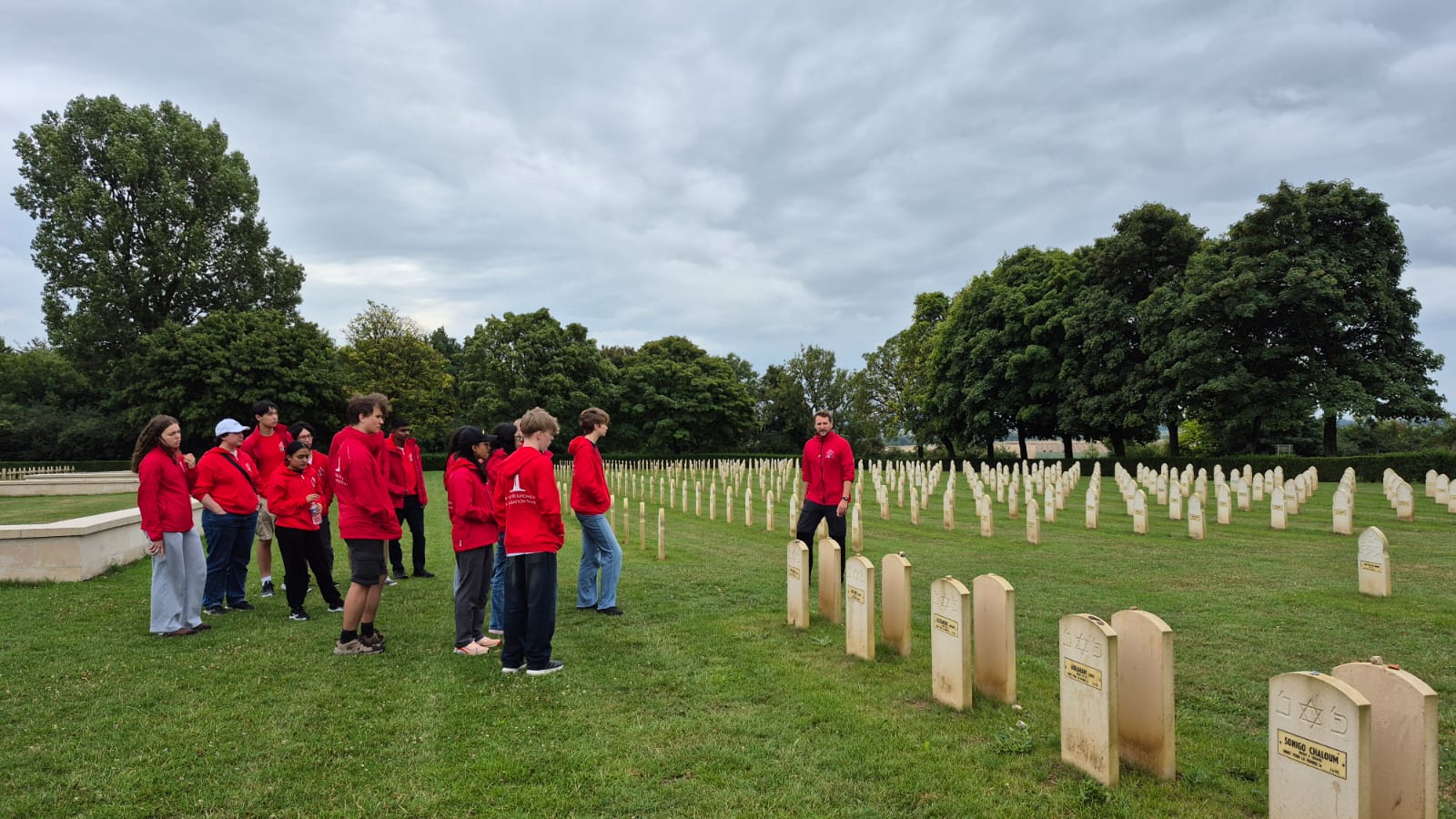
This first day set the tone for what promises to be a meaningful and thought-provoking journey. With curiosity, respect, and a shared sense of purpose, the participants of the 2025 Beaverbrook Vimy Prize are ready to begin their exploration of history across Europe.
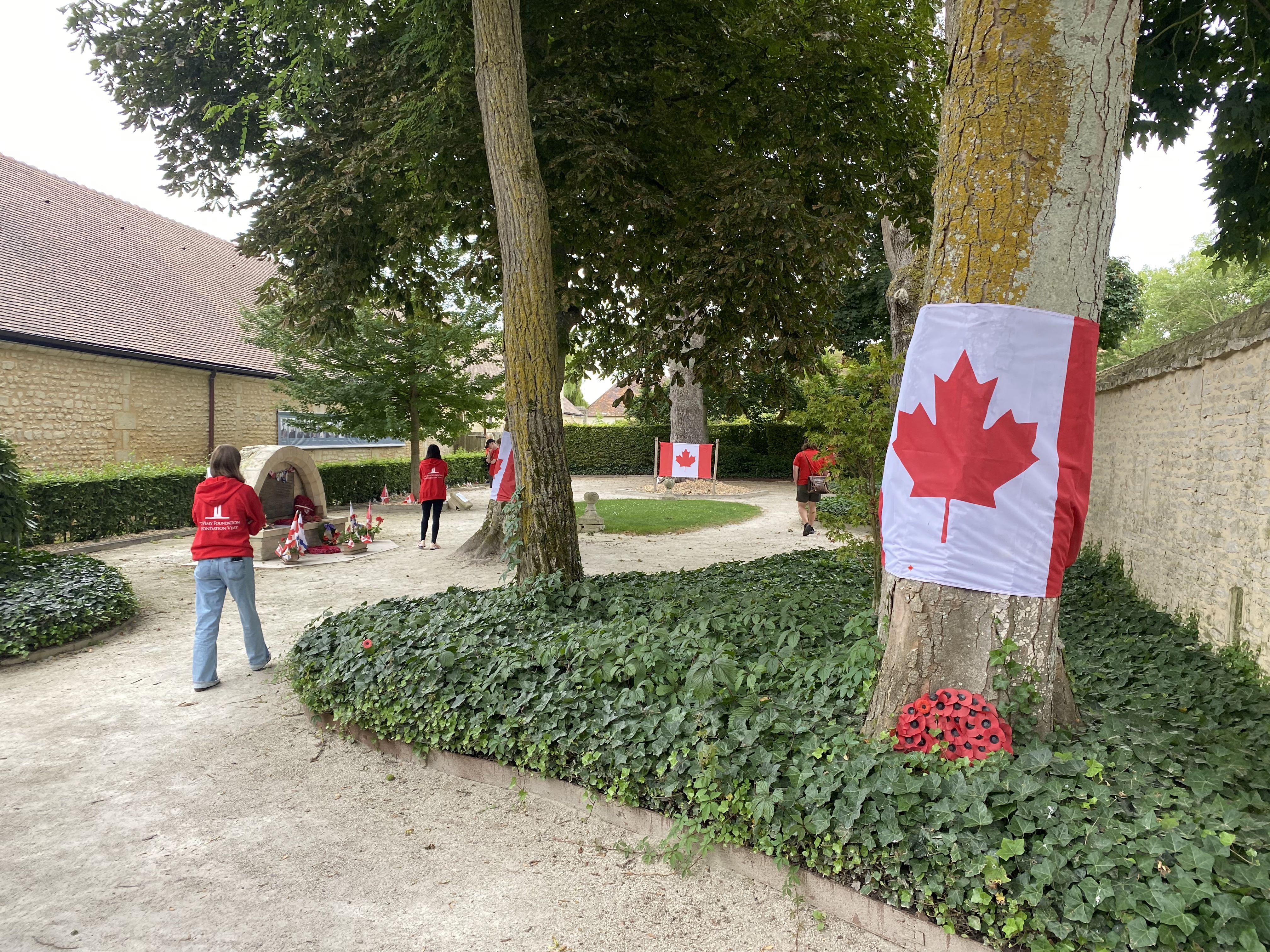
On the second day of the 2025 Beaverbrook Vimy Prize program, students visited a series of sites in Normandy connected to the Second World War.
They began the day at the Polish Cemetery in Urville, where they learned about the contributions of Polish forces during the Normandy campaign. This was followed by a visit to the Mémorial de Falaise – Les civils dans la guerre, which highlights how civilians experienced and endured the war in the region.
The group then visited the Memorial to Canadian Aviators, before continuing on to the Bretteville-sur-Laize Canadian War Cemetery, where more than 2,700 Canadians who died in the summer of 1944 are buried.
The day concluded at the Abbaye d’Ardenne, where 20 Canadian soldiers were executed during the Normandy campaign.
Today, Louise and Jayden shared their reflections on the day’s experiences.
Jayden Ly
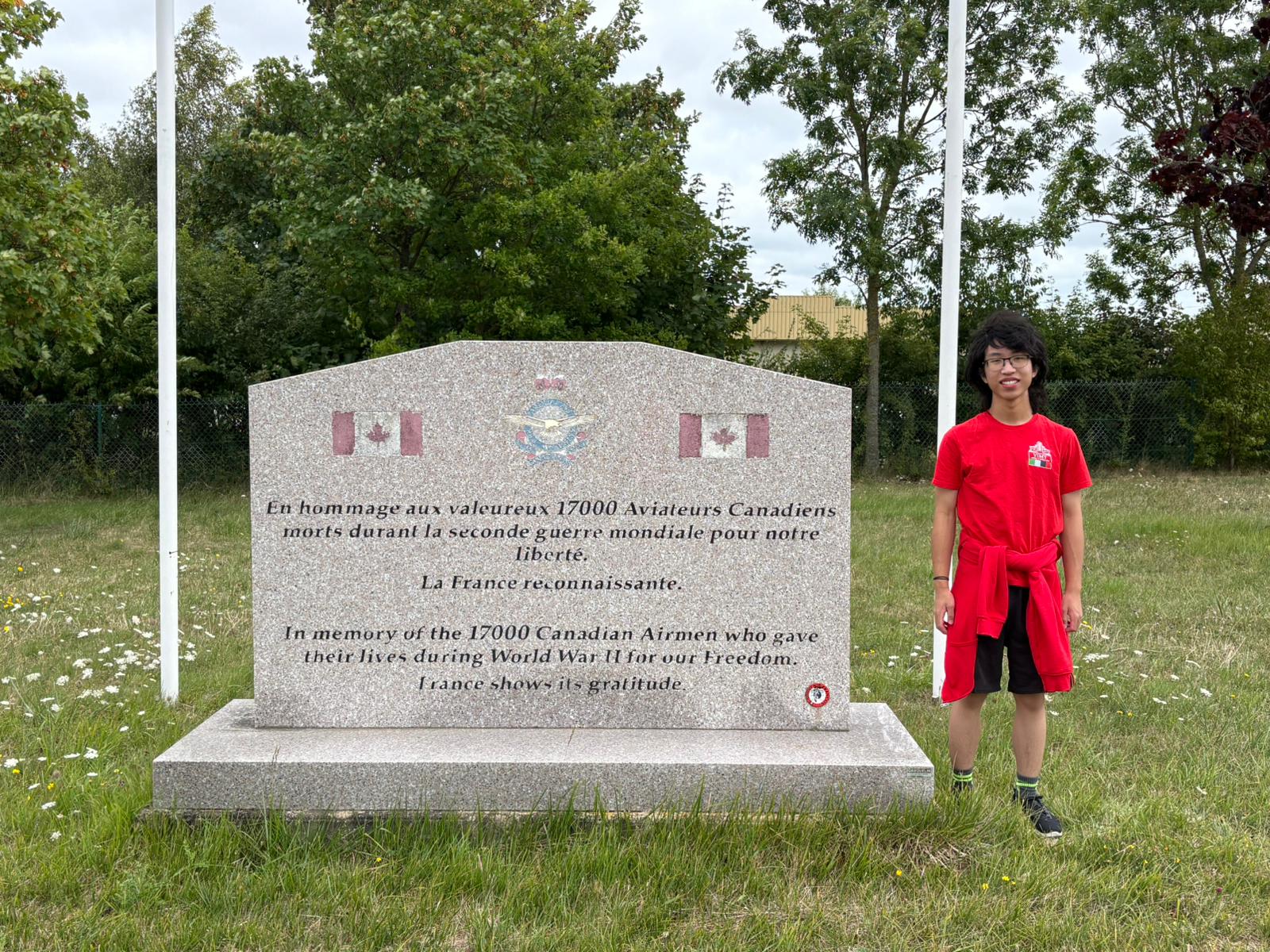
Today we were able to visit a few different sites, with a bit of a solemn theme. Visiting two different cemeteries, a museum dedicated to the civilian’s wartime experience, and the site of an execution, the BVP has already given me insights and knowledge I wouldn’t have otherwise.
I found one of the most interesting things was being able to compare the different styles of cemeteries presented to us so far. Yesterday we visited a French cemetery, and today we visited a Polish and Canadian one. Seeing the common themes between the cemeteries was eye opening. For the French and Polish ones instance rows and columns reminiscent of an “army of dead” showing the scale of death the wars caused. Equality in death is common for all three of them, with soldiers being buried side by side, regardless of their rank. One I didn’t expect was the care taken to make sure the personal views of the soldiers were represented, giving relevant religious symbols to those they could. There were also all the flowers, being common in each cemetery and providing a beautiful sight thanks in part to the volunteers who dedicate their time here. The differences also told a lot about the different nations. Each of them possesses their own philosophies, concentrating the fallen from all over the area to provide a grand place of remembrance, or those keeping them resting as close as possible to where they fell. All these different resting places are really putting into perspective the respect and appreciation of French people for the allied soldiers who fought and died here.
I also had the opportunity to present my biography of a soldier to my peers as we visited a remembrance stone dedicated to all Canadian airmen killed, including my own. The process of researching and putting it down for others was a unique experience for me. Being able to share what I have found on someone who hasn’t had their story shared before and to talk about the impact that had on me was an incredible opportunity, and made me feel proud about the effort I put in. The amount of information and stories waiting out there for people to discover, and the personal relevance this biography had to me showed me the importance of keeping those memories alive. Even though, my soldier being buried in Germany, I was not able to visit his grave in person, the process of learning more about him gives me hope that one day I will.
Louise Ogbinar
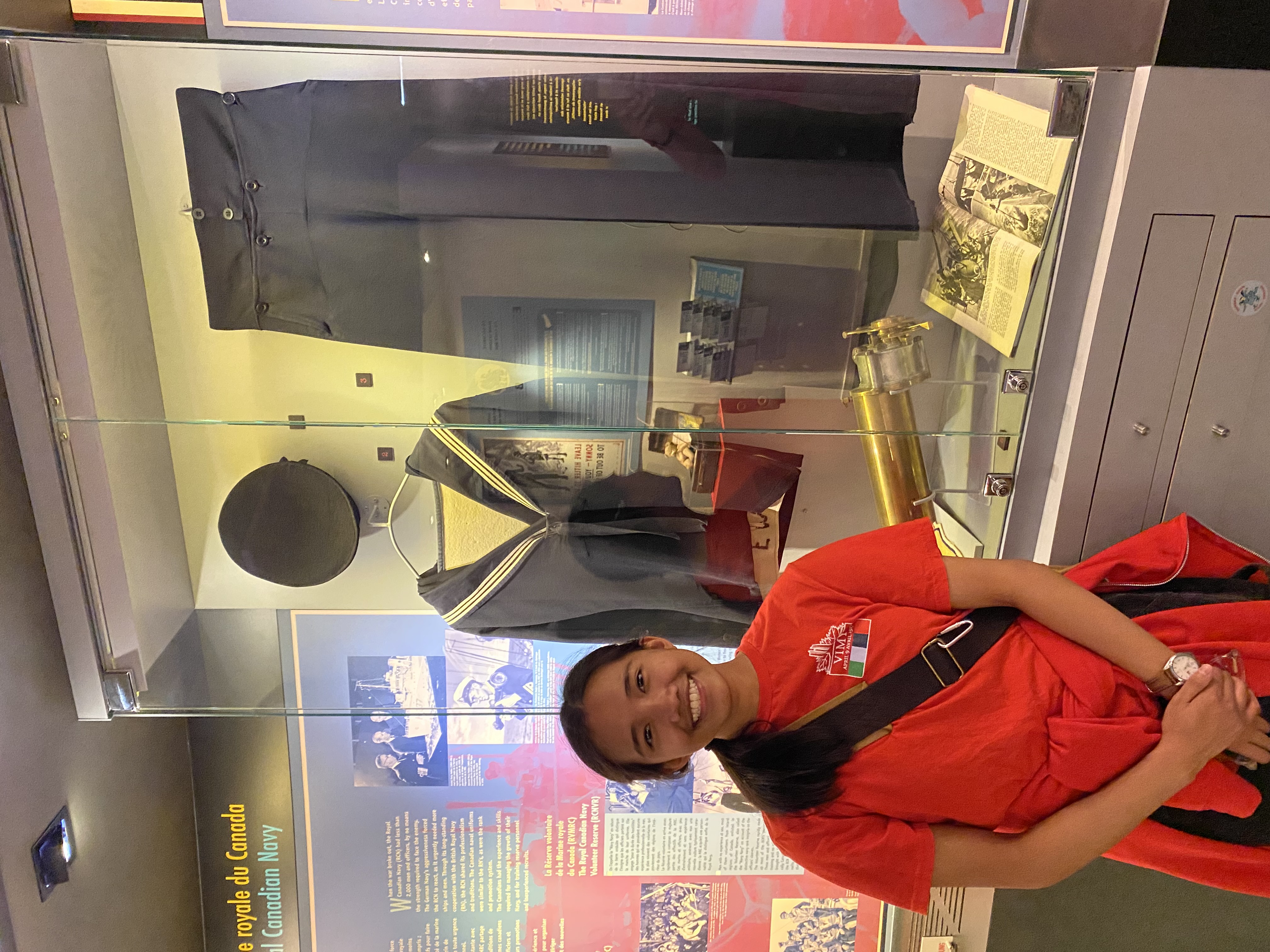
We visited the Falaise Musée des Civils dans la Guerre, where we watched an immersive short film that showed us the realities of the bombings of Falaise and other surrounding towns. Beneath the glass floor of where we watched the movie, were the remains of a house that was bombed, with shattered plates and burned belongings. We all left with a deep silence, seeing just how devastating the reality was for civilians during the Second World War, where more civilians had died than soldiers. The emotions throughout this museum were heightened, reminding me of the futility and pain of war, and asking myself the question of empathy, and its role in our humanity.
Towards the end of the day, we visited the Cimetière Canadien Bretteville Canadian Cemetery, where Uzziel, George, and I presented about Indigenous Peoples and Canada’s War Effort! We talked about Indigenous contributions on the home front, the different and conflicting attitudes towards enlistment and conscription, and the roles and experiences of Indigenous Soldiers. We also discussed the post-war attitudes towards Indigenous individuals and communities, and reflected on how racism and discrimination impacted Indigenous experiences during and after the wars. This topic is quite significant, as it has broadened all of our perspectives and understandings of Indigenous involvement in Canada’s War Effort, especially on the home front. Many Indigenous communities and individuals contributed and donated thousands of dollars, and created organizations to help support and fundraiser money for the war, such as the “Six Nations Women’s Patriotic League.” However, equality and proper recognition and respect would take decades for Indigenous Peoples. Today, it’s important to remember the stories of Indigenous contributions, stories, and Indigenous men who proved to be exceptional soldiers and snipers. As well, we reflected that while many Indigenous communities supported the war effort, this was far from a unanimous point of view. We remember that despite the discrimination they faced, Indigenous and minority Canadians fought with courage and determination for a country that didn't always feel the same for them. History is never one-dimensional. When we talk about reconciliation, we learn that it begins not just with remembering history, but with understanding and taking on responsibility and action because of it.
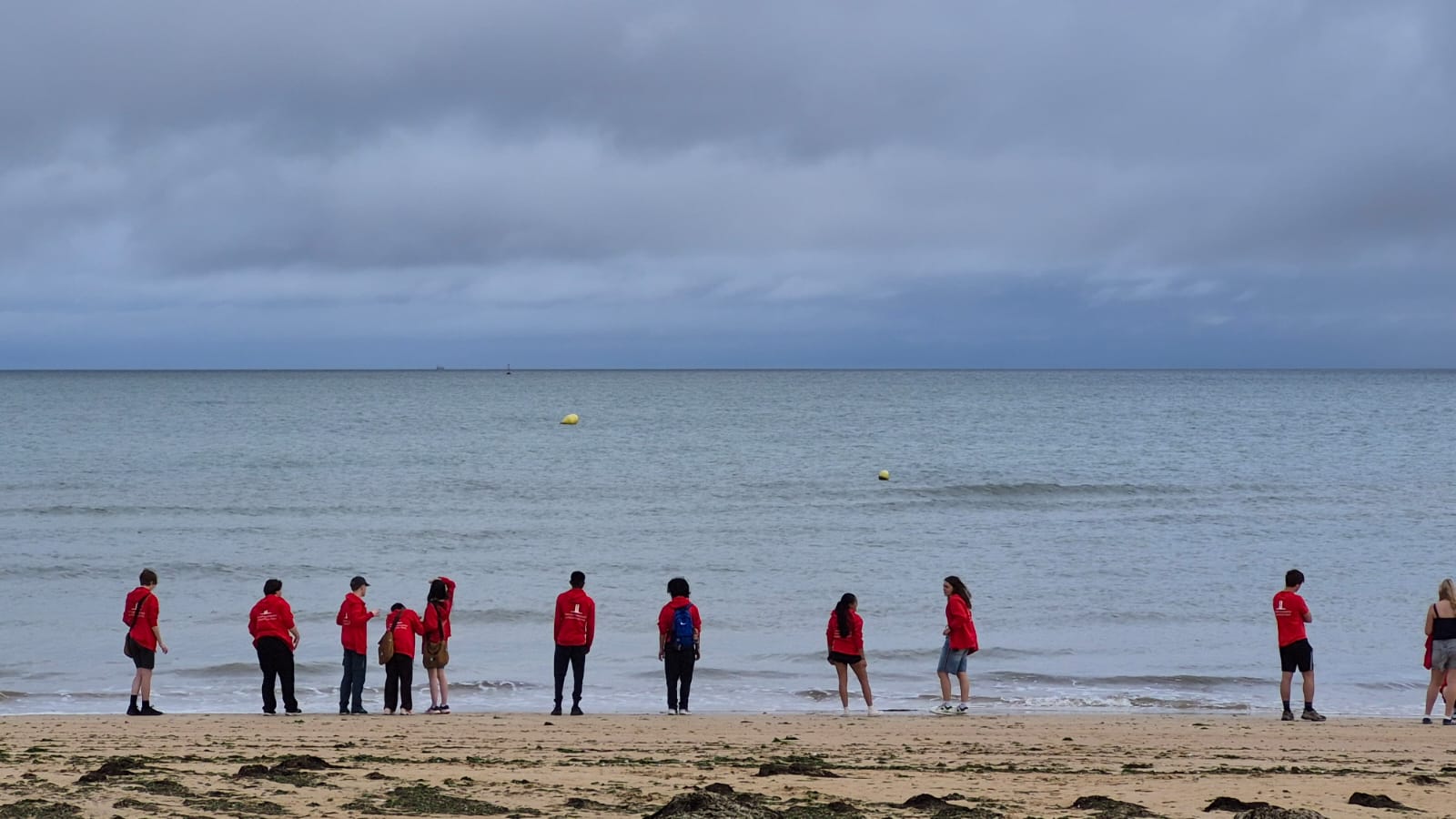
On the third day of the Beaverbrook Vimy Prize program, students explored several key sites along the Normandy coast connected to the D-Day landings and their lasting legacy.
The day began at the Juno Beach Centre, where the group received a guided tour from Vivian, learning about Canada’s role on D-Day and in the wider Normandy campaign. They then visited the nearby British Normandy Memorial in Ver-sur-Mer, a site honouring those who served and fell during the liberation of France.
Next, students headed to Arromanches, where they saw the remains of the Mulberry Harbour and took part in a discussion on the environmental impact of the war — both at the time and in the decades since.
In the afternoon, the group visited the German War Cemetery at La Cambe, a place of reflection on the human cost of conflict from all sides. The day concluded at Canada House in Bernières-sur-Mer, one of the first homes liberated by Canadian forces on June 6, 1944.
Today’s reflections are from Étienne and Ellis, who offer their personal thoughts on the day.
Étienne Laroche
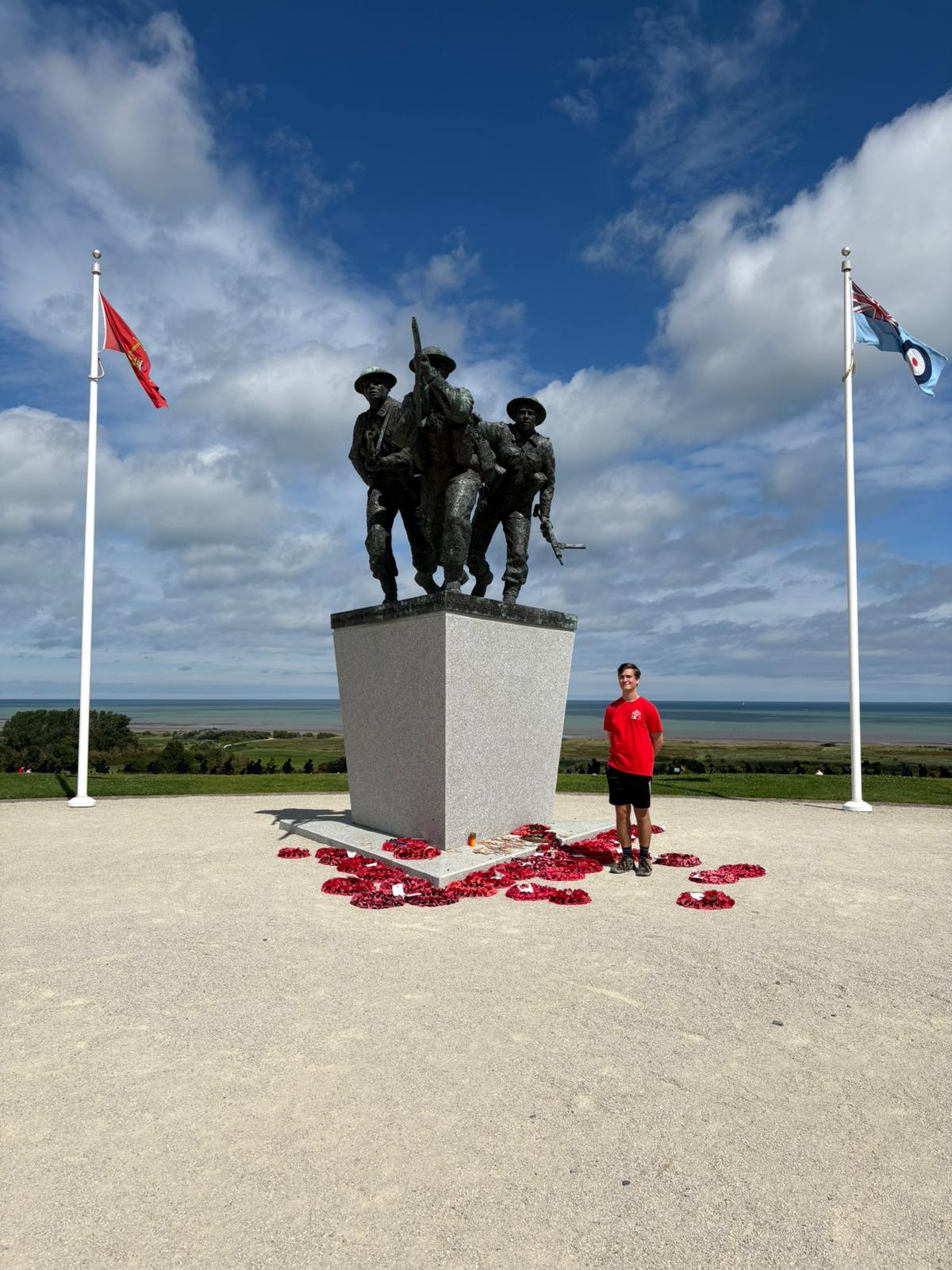
Today, we visited some of the Normandy landing beaches, the British monument at Ver-sur-Mer, and the German cemetery at La Cambe. All were as majestic as they were meaningful, both for those directly affected by these events, such as family and veterans, and for us, young people traveling to all these sites to learn more about the history of our country, but also to be able to perpetuate the memory of those who sacrificed for our freedom. At the sites, what surprised me most was the fact that many of the monuments were erected several years after the Second World War. For example, the British Normandy Memorial at Ver-sur-Mer was only inaugurated in 2021, more than 75 years after the war. The German cemetery was completed in 1961, which is almost two decades after the conflict. Why wait so long to commemorate the soldiers? In fact, there are several reasons, depending on the monument. For La Cambe cemetery, the reason is quite simple: no one had permission to build German Second World War cemeteries before 1954 due to political tensions. This is why construction on this one only began in 1958 and was completed in 1961. The main reason for the British Normandy Landing Memorial is that, due to the First World War, several monuments had already been built in honor of the soldiers in various locations. So, instead of building new ones, governments decided to simply add the commemoration of Second World War soldiers to the existing monuments. However, for the 77th anniversary of the Normandy Landings, this initiative aims to erect a monument dedicated to the dead of this significant event of the war where it took place. Overall, it has been very inspiring to see all the recognition we give to the soldiers who served.
Ellis Thorne
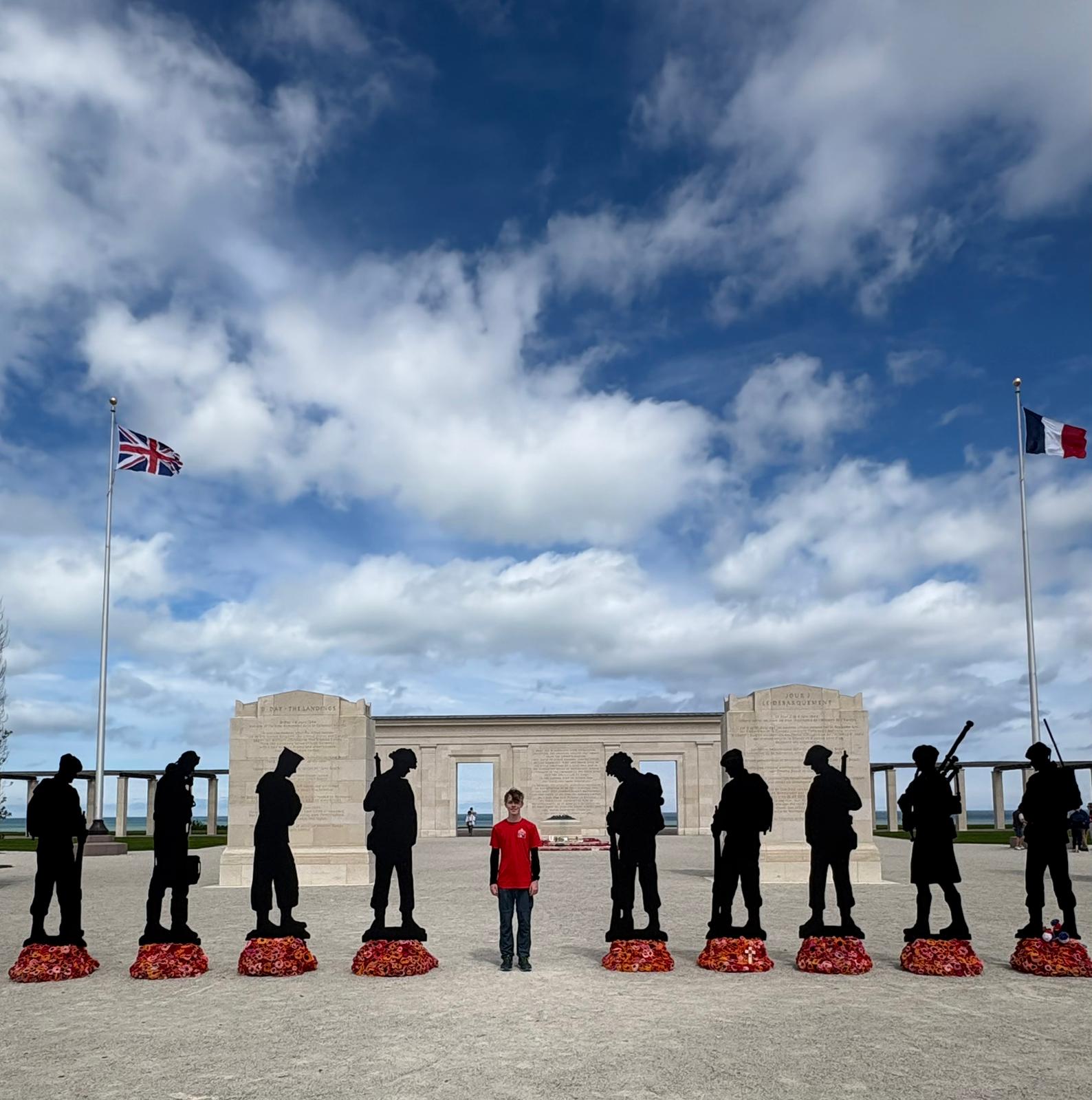
Today’s sites that we visited were truly eye opening as it was the first time throughout these past few days where I felt a pit of sadness in my stomach. We got to watch a short film at the end of the tour at Juno Beach Centre, allowing everyone to understand the emotional aspect of the event. One particular part that made me emotional was the ending - it showed a family walking across Juno Beach, speaking about D-Day and gradually, soldiers appeared walking behind them. This scene made me realise that every soldier has a story and how it is essential to recognise them so their memory stays alive.
At the Juno Beach, where the allied forces landed on the morning of June 6th 1944, we had a tour through a bunker which was used by German soldiers as a form of command. This bunker however was completely improvised as it was built before the bunker catalogue was created, so aspects like the materials inside varied widely. What intrigued me was how the bunker was built. The Nazi régime created the STO (compulsory work service) for French civilians as the soldiers didn’t have enough time to build. As a result, many structures including bunkers were constructed by the STO alongside prisoners of war. During the building of the bunker, they used cinder blocks but placed them on the side, meaning concrete couldn’t go through the holes and solidify, leaving it weak and likely to collapse. It was most likely a way to sabotage the Germans which I thought was very smart, especially how they must’ve been under a lot of pressure, trying to not get caught by a German soldier.
Also, once on the beach, it was difficult for me to imagine that there were humans who died directly where I was standing because it is so beautiful and calm now. When you are able to properly immerse yourself within the past, you start to appreciate everybody who fought for a better world more. At Gold Beach, which was another landing sight at D-Day where part of the British contingent landed. At this beach is a memorial for British soldiers which I found to be really unique in comparison with other memorials we’ve visited. This is because each soldier’s name is engraved on a pillar and in total, there are over 22,000 commemorated servicemen and women. The way all of the pillars were arranged creates a sense of unity and peace, which made me feel like I did not have to be dejected by the thought of fallen comrades, but more so happy that we are able to honour them and give them the respect they deserve. In conclusion, today let me experience both sides of the Battle Of Normandy/ D-Day in a way I have not yet done. I think having the chance to stand where history took place changed the way I will view battles as we progress through the program.
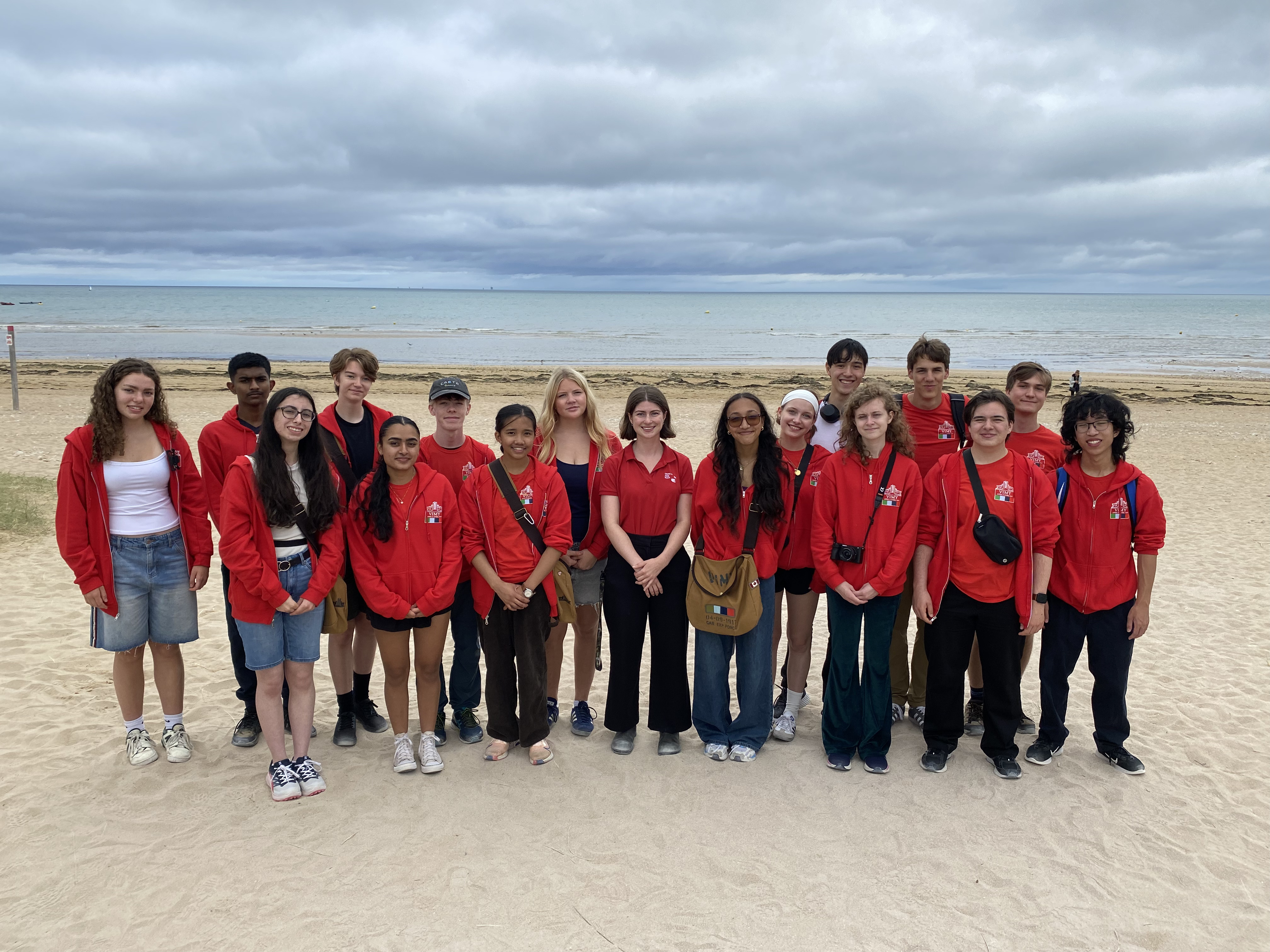
.jpeg)
On Day 4 of the Beaverbrook Vimy Prize program, students visited sites that offered both historical and contemporary perspectives on the impact of war.
The day began at Ouistreham, on Sword Beach, where historian Xavier Michel from the University of Caen gave a presentation on the environmental legacy of Second World War sites and the effects of climate change on these coastal landscapes.
(This session was made possible with the support of La Fondation de France — thank you!)
The group then travelled to the Bény-sur-Mer Canadian War Cemetery, where they met Lucie and Samuel from the Commonwealth War Graves Commission (CWGC). The visit provided insight into the ongoing work of caring for Canadian war graves in France and the importance of preserving these spaces.
In the afternoon, students visited Pourville, where they saw the memorial to the 2nd Canadian Infantry Division and reflected on its role in the Dieppe Raid of 1942. They then continued to Dieppe Beach, where they marked the site of the August 19, 1942 landing, one of the most costly days for Canadian forces during the war.
Today’s reflections are from Gideon and Alexandra.
Alexandra Ouellet

Today we had the opportunity to visit the Canadian War Cemetery in Bény-sur-Mer. Four of us introduced our soldiers, who were commemorated there. Jeeya told the moving story of five brothers, three of whom fell in combat. Next, I introduced a soldier from the same region as my family, the Lower St. Lawrence. Then, Milène introduced a soldier who, like her, spoke French and English, among other languages, and lived in Saskatchewan. Finally, Étienne introduced another soldier from Quebec, who was in the same regiment as mine.
I found these presentations extremely informative and it really demonstrates the magnitude of the war and how many lives are too little known despite the fact that they are all particularly interesting. It made me think a lot about what drove the different soldiers to sacrifice everything to go to the front. I realize that it will probably never be possible to know all their stories, several decades after the war, there are still bodies being discovered and stories resurfacing. I loved seeing all the efforts put in place by the Commonwealth War Grave Commission to ensure that the lives of these soldiers are never forgotten. Everything that is placed at the feet of the graves, instead of being thrown away after a period of time, is preserved. They also ensure that the inscription on their graves remains legible.
I really enjoyed learning about these six lives, and I wish I could learn about all those who sacrificed their lives for our freedom. This program allows me to visualize the scope of the World Wars and better understand them.
Gideon Emke

Today for the BVP program we went to Sword Beach, Beny-Sur Mer, and Dieppe. Sword Beach is one of two British landing beaches. Unlike the other D-Day beaches, when we went to Sword Beach it was not as readily commemorated with large monuments or the shadows of soldiers like Gold Beach. However it was still impactful, we walked the Path of Peace and saw the Flame Statue. Even though we saw Juno beach yesterday, Sword beach was still very striking, I could better picture what landing here might have been like as there were no dunes or impediments to the water. After that we went to Beny-Sur Mer, a Canadian cemetery, filled with soldiers no more than a few years older than my peers and I, many of whom landed on D-Day. Seeing D-Day where most of these young men fought and then the cemetery where they were buried was sobering. I can’t help but wonder what parallels there are between our group and the groups of similar demographics would be like before they landed on D-Day.
Part way through our visit of the Beny-sur-Mer Canadian cemetery, the head Gardener Samuel showed us the various mementos he had from people placing on graves, photos of Brothers smiling now buried together, or stories of descendants coming to France to find closure breaking down in his arms. It made me reflect on whether there was any honor in war and death. Through history Honor in death has been accepted unquestionably, Ancient Greece ony engraved the graves of Soldiers who died in Battle or mothers in childbirth. for the Romans dying for their empire was the pinnacle of virtue and the greatest achievement. The crusades used promises of glory and religious redemption to muster armies. Throughout history men have sought glory on the battlefield readily volunteering for war hoping for fame might power, but when we see the videos and pictures of soldiers our age lying face down in the mud disfigured and bloody the notion of glory seems ridiculous, replaced by the feeling of missing someone who never would grow old.
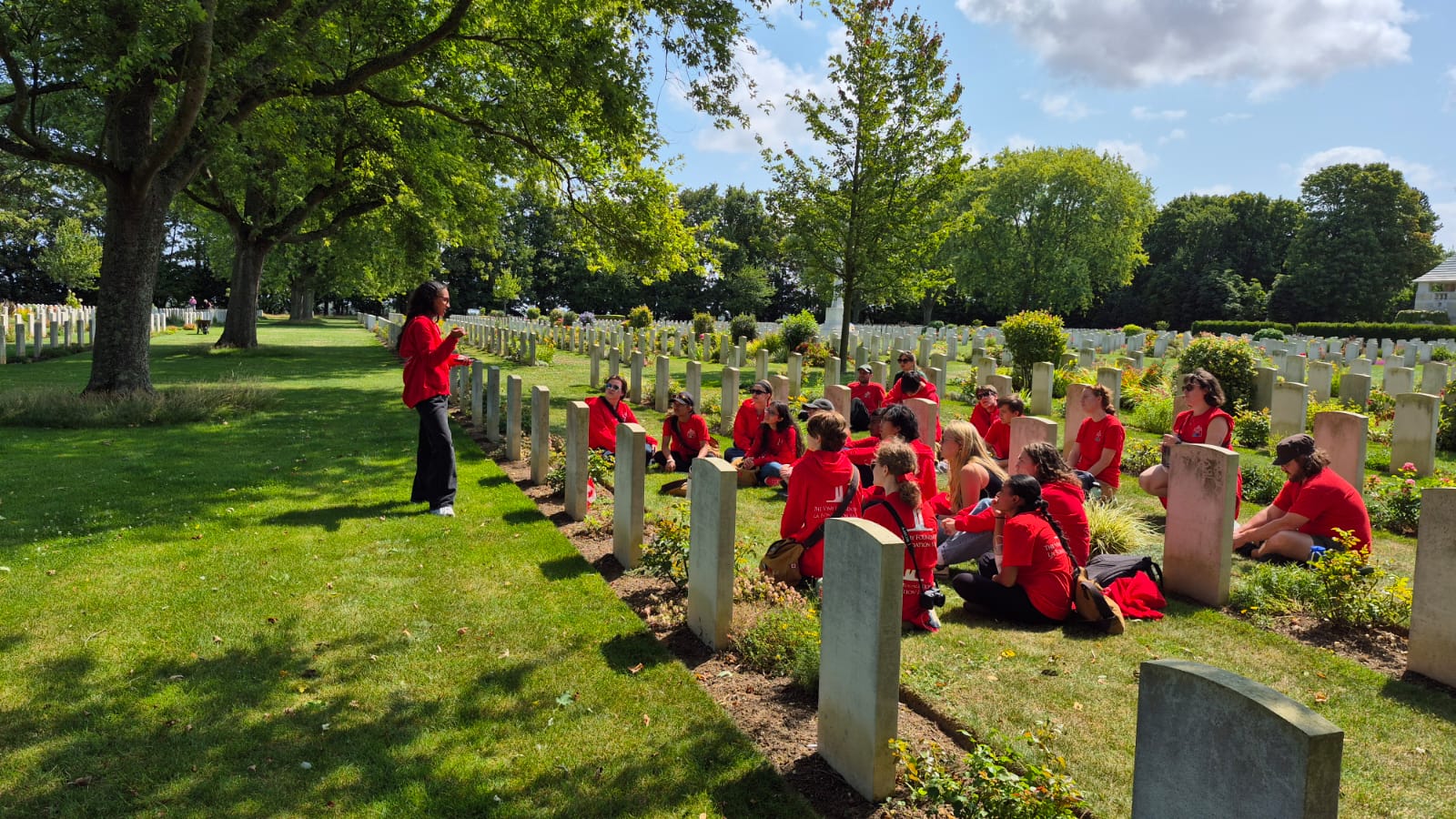
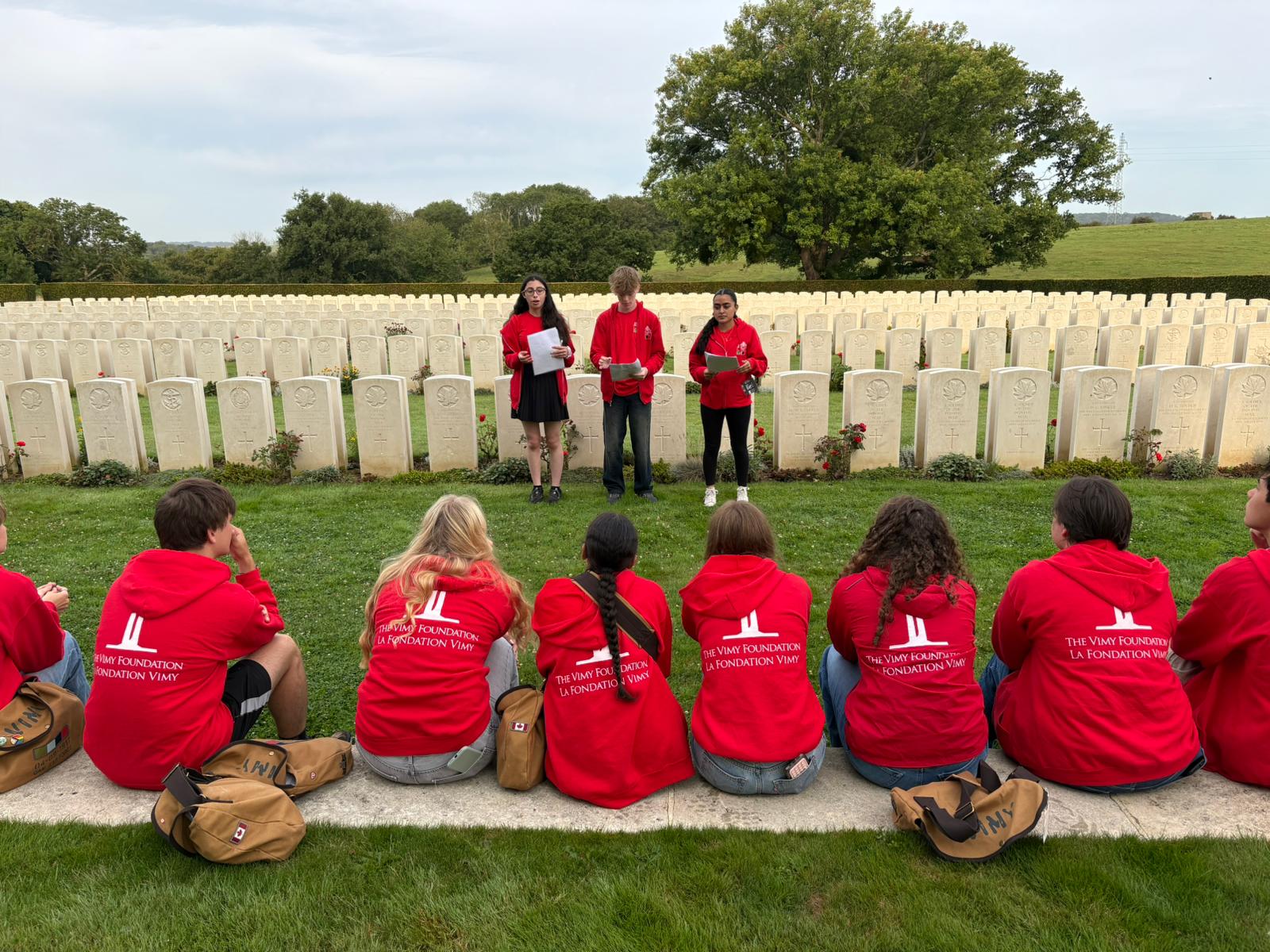
On the fifth day of the Beaverbrook Vimy Prize program, students visited several key sites connected to both World Wars, exploring how Canadians and their allies served and sacrificed across northern France.
The day began at the Dieppe Canadian War Cemetery, where Jeeya, Ellis, and Michelle led a presentation on Women on the Front Lines — highlighting the contributions of nurses, resistance fighters, and other women who shaped wartime efforts.
Students then continued to Étaples Military Cemetery, the largest Commonwealth cemetery in France, where over 11,000 service members are buried. They reflected on the scale of loss and the role the site played during the First World War as a major hospital base.
Next, the group visited Wimereux Communal Cemetery, the burial place of John McCrae, author of In Flanders Fields.
The final stop was Dunkirk, where students walked along the beach and visited the Allied Memorial marking Operation Dynamo, the massive evacuation of Allied soldiers in May–June 1940. The visit offered an opportunity to discuss the early stages of the Second World War.
Reflections from today’s activities were written by Paris and Michelle.
Paris Ford
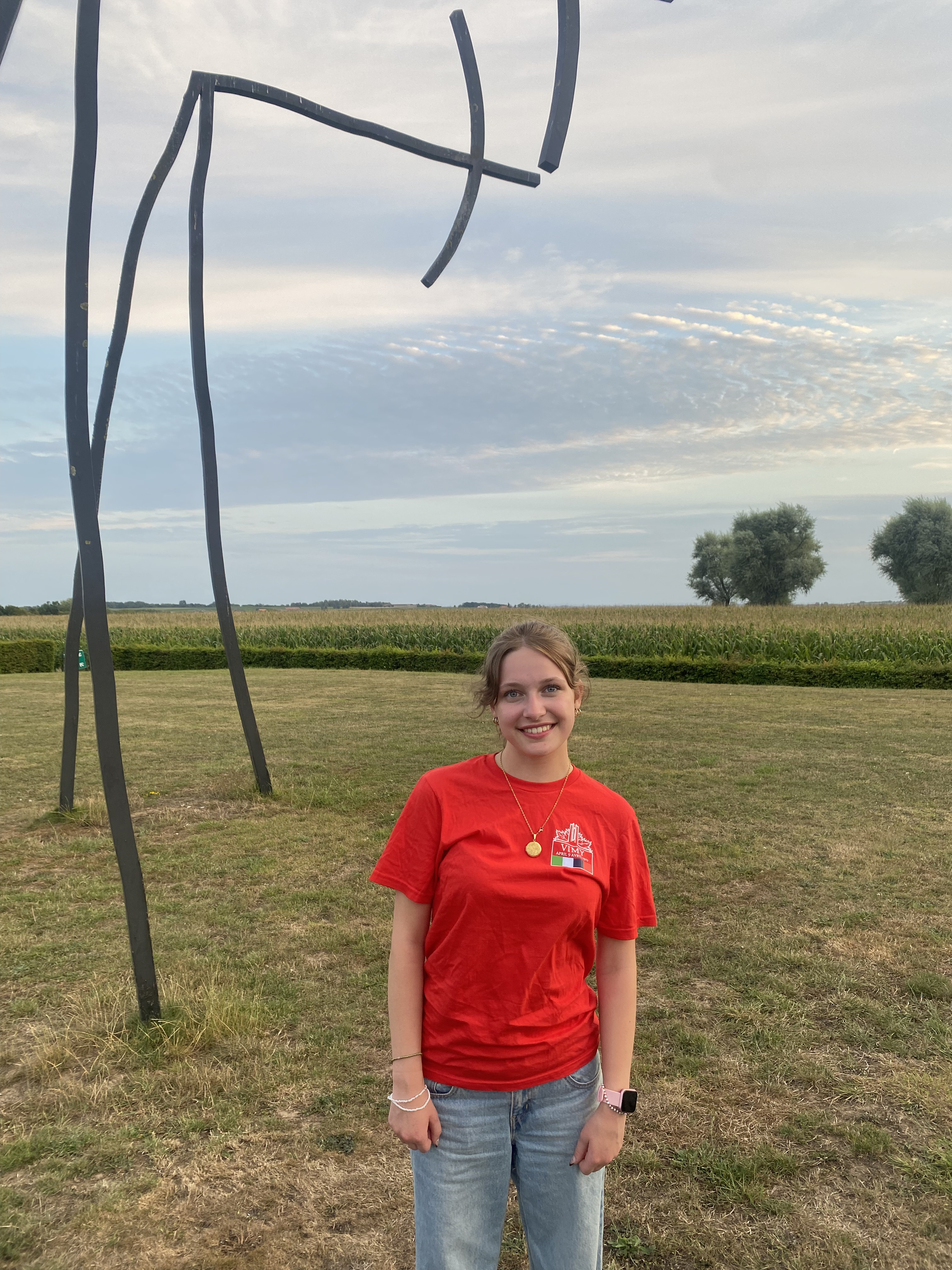
So far during the BVP program, we visited many sites and cemeteries; ones that housed tens of thousands of fallen soldiers and ones that had a handful. Étaples Military Cemetery, however, was the one that stood out most to me. Here, many soldiers are buried but not only. The cemetery is also the burial place of many female military personnel and nursing sisters alike. Walking into the cemetery, seeing all of the similarly shaped yet differently marked graves lining the field as they would have to prepare for combat was breathtaking. Between the vast amounts of headstones, the scenery, and the massive stone monument, Étaples stole the words from my mouth.
Both the First and the Second World Wars were privy to a mass phenomenon of sexual violence against women and girls. The violence caused by military men was never generally reported until 1915, when the first proper case was reported. The report was published by nearly every newspaper, and was one of the first to prove that the general reports were not just propaganda, but real crimes. However, the reports hadn’t been about what the women went through, it was about the men's dishonour. The “shame” of not being able to protect “their women” caused the men to be projected as the true victims…
The sexual violence reports were hard to prove because of the conditions and nature of the assault, usually in the dark and similarly clothed perpetrators. It was testimony against testimony, and judges were not inclined to believe the woman over a soldier.
Hearing this for the first time before seeing the graves of many women who served in the war was jarring. I hadn’t heard of these events before now, and I am filled with sympathy for the women and girls that had to go through those atrocities. I am looking forward to learning more and being able to reconcile more.
Michelle Jiménez-Bucur
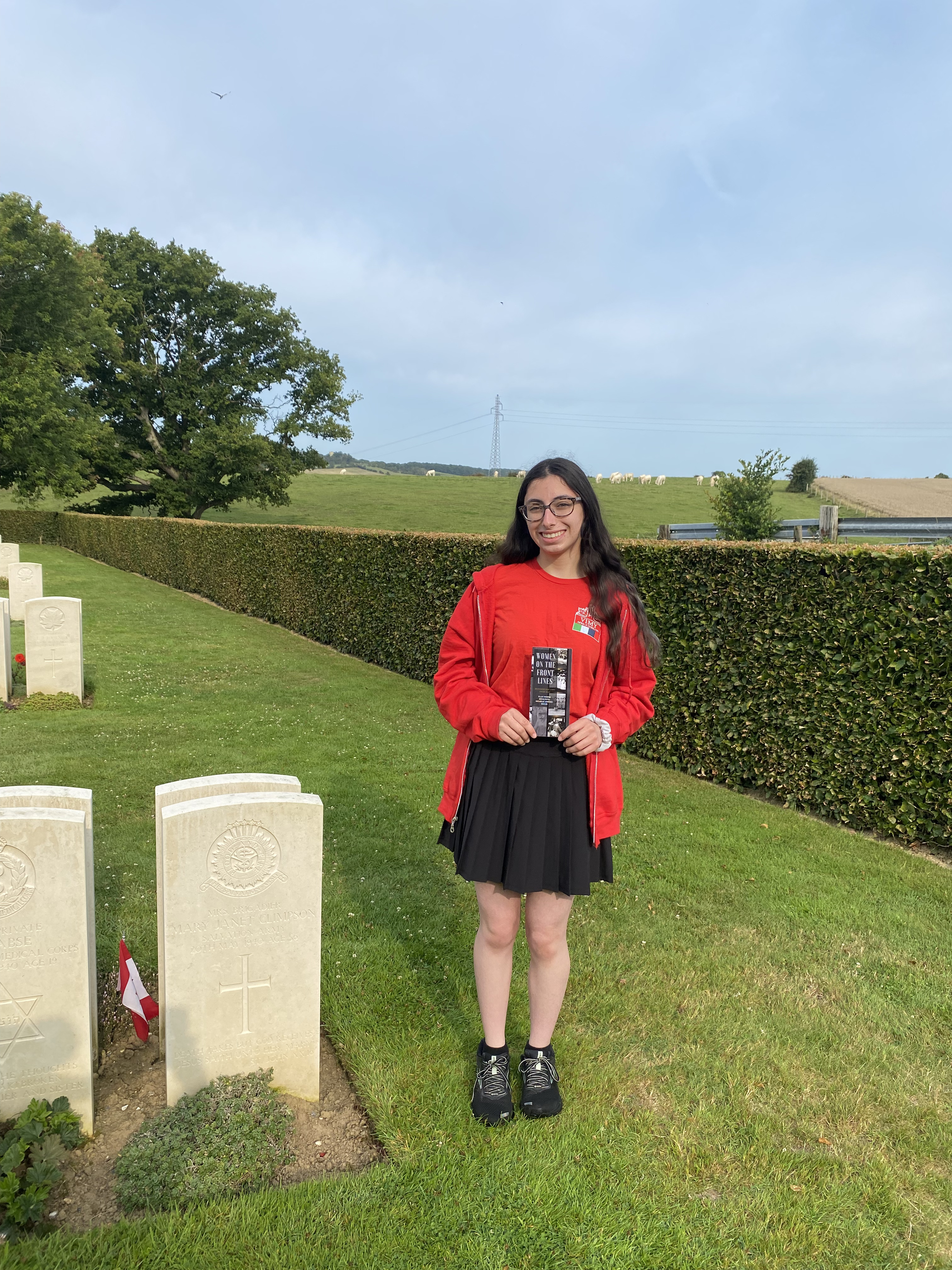
Today had a different feel to it, as we focused on women’s role in both World Wars. Though we’ve been visiting all kinds of cemeteries for the last five days, today was the first time we saw a woman’s grave, which for me is truly mind-boggling. The non-existence of female-only cemeteries, for both World Wars, show me just how much women were never properly commemorated, and specially as they contributed so much to the war effort, stories that are often found in the cracks of history books and films.
Luckily, the BVP gave me the opportunity to dive into the subject of “Women on the Front Lines” for my field group presentation, which my team and I presented today! For my part of the research, I studied specifically about the contributions of female telephone operators and espionage on the Western Front. For instance, in the First World War, the United States had to turn to Canada to find bilingual, in English and in French, women to work as telephone operators in France. So, by March 1918, 15 brave Canadian female telephone operators embarked on their journey to the front lines. Even then, veteran status was out of reach for them, until almost 60 years later, in 1977. And the worst thing is that I’m not even surprised, which is sad.
Additionally, while women continued gaining and fighting for more rights during the interwar years and the Second World War, gender bias and sexism made it so that women and their contributions in war efforts were overlooked and undermined. In fact, today, during Chloé, one of our chaperones, I was shocked to learn how society, in the First World War, spun the narrative of sexual assault, referring to it as “sexual with violence” instead of “violence with sexual orientation”.
Therefore, it is essential to learn, remember and share about the courage and hard work of women, who did the jobs no other could, in a sexist environment. I really admire all these women, from nursing sisters, to spies, to ambulance drivers, to combat roles in the Second World War, and so many more. It’s why we must keep their contributions in mind, as the fight for gender equality is still in the process.
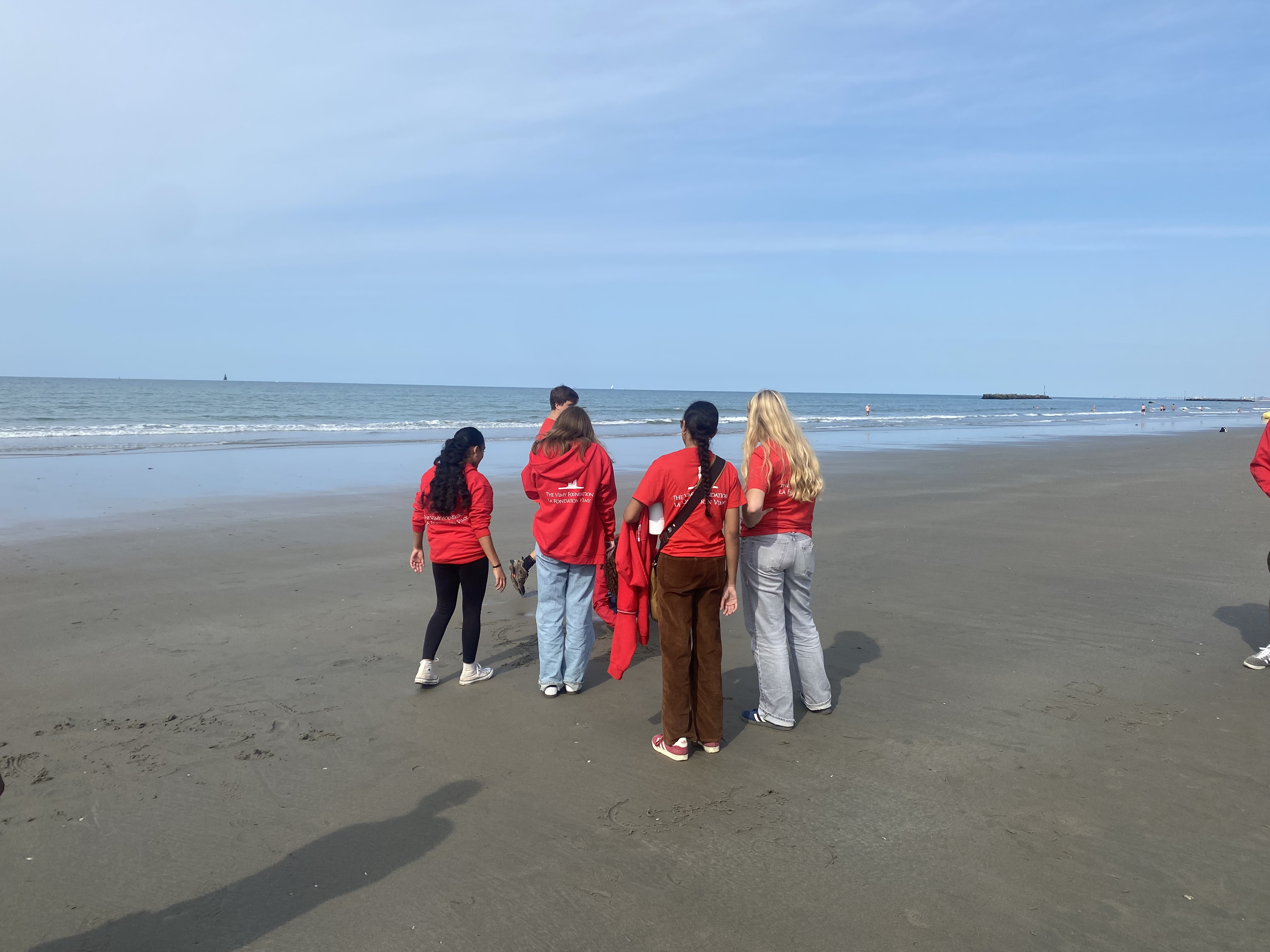
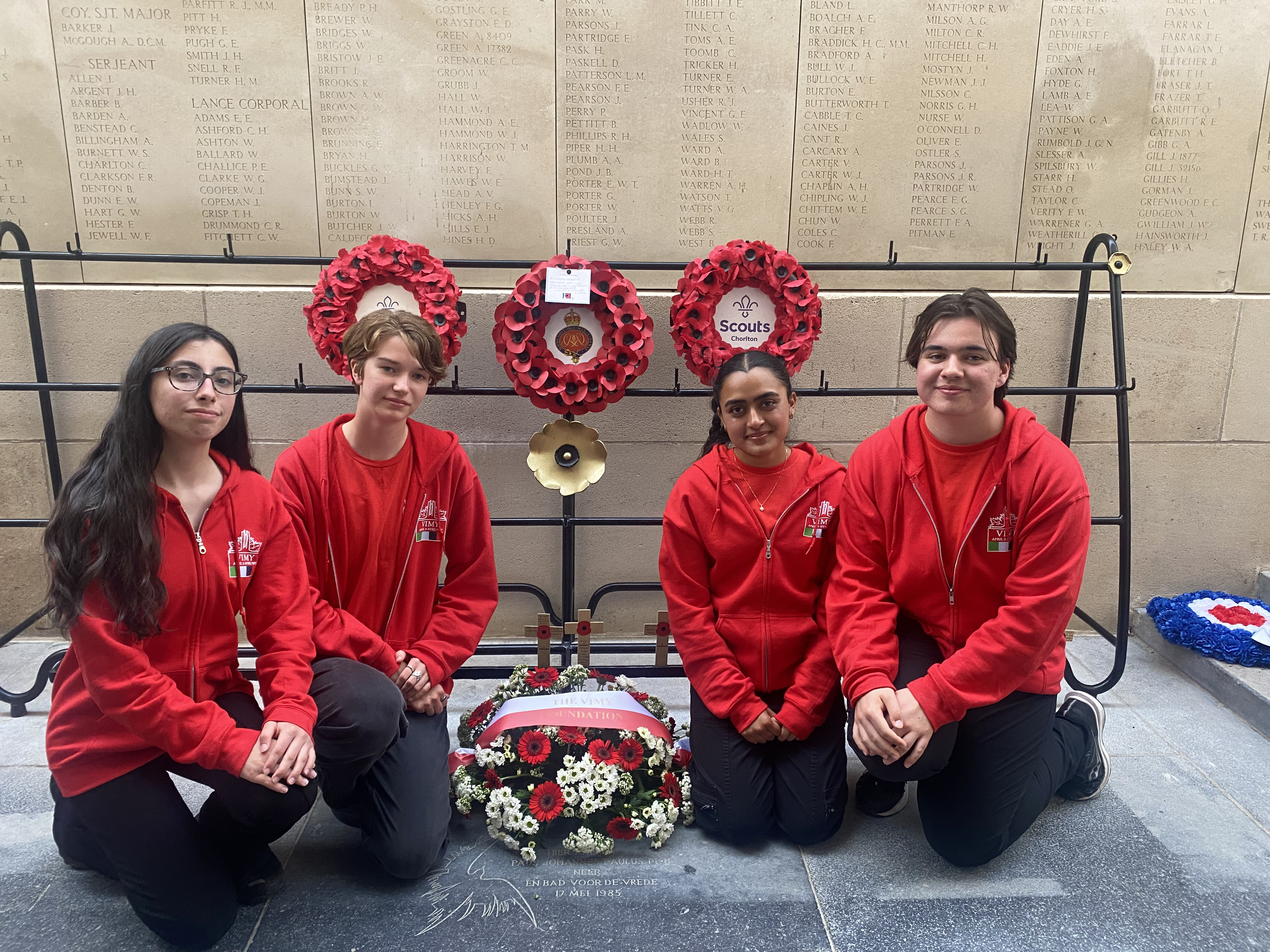
On Day 6 of the 2025 Beaverbrook Vimy Prize program, students were guided by Kim from Kim’s Battlefield Tours through several key sites connected to the First World War in the Ypres Salient.
The day began at the Christmas Truce Memorial, where students reflected on the unofficial ceasefires of 1914. They then visited Hill 60 and the Tyne Cot Cemetery — the largest Commonwealth War Graves Commission cemetery in the world.
In the afternoon, the group visited the St. Julien Memorial, also known as the Brooding Soldier, which commemorates the first gas attacks and the Canadian soldiers who endured them. From there, they continued to the Langemark German Cemetery and Essex Farm Cemetery, where John McCrae wrote In Flanders Fields.
The day concluded with the Last Post ceremony at the Menin Gate, where the students had the opportunity to witness this daily act of remembrance in Ypres.
Reflections today come from Olivia and Alaynna.
Alaynna McCurdy
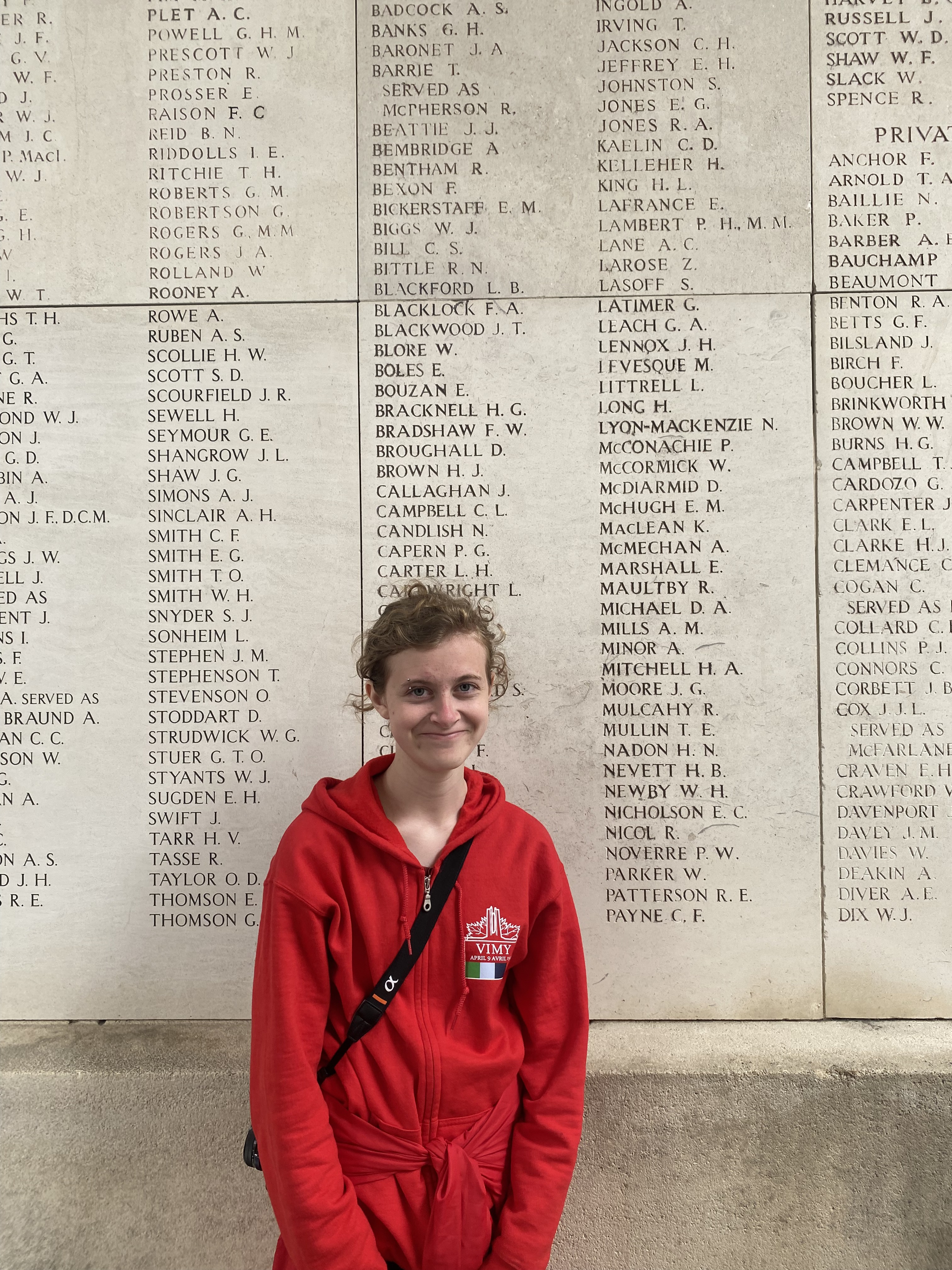
Today on day 7 of the program, we were present for the Menin Gate ceremony, which is a daily ceremony dedicated to the soldiers with no known grave.
We were surrounded by at least 100 people who came to witness the event in which a random person from the crowd is asked to recite the ode of remembrance, and groups may lay wreaths for the soldiers. As any typical form of a remembrance service, there was the playing of the bugle, as well as the moment of silence. Every day this ceremony takes place and hundreds of people come each and every day.
As our BVP group were standing in line, with our heads hung low, and the bugles playing in the background, I couldn’t help but shed a tear. It is emotional itself to imagine what each soldier went through on any normal day or even at your local Remembrance Day service, but being right there, where the battlefield once littered the ground, it truly is a different feeling. It is such a different experience to be directly where millions had fought and died, as well as the feeling of being “put in their shoes” makes the moment definitely more surreal. The idea that millions of people have visited this ceremony, and has taken time out of their day to remember those who fought so desperately hard for even an inch of land is astonishing.
I would definitely recommend going to the Menin Gate ceremony to anyone whom enjoys learning about history, as well as just to anyone who has never been, or only been once. I one day hope to visit this site again in the future and get to experience this beautiful event once more.
Olivia François
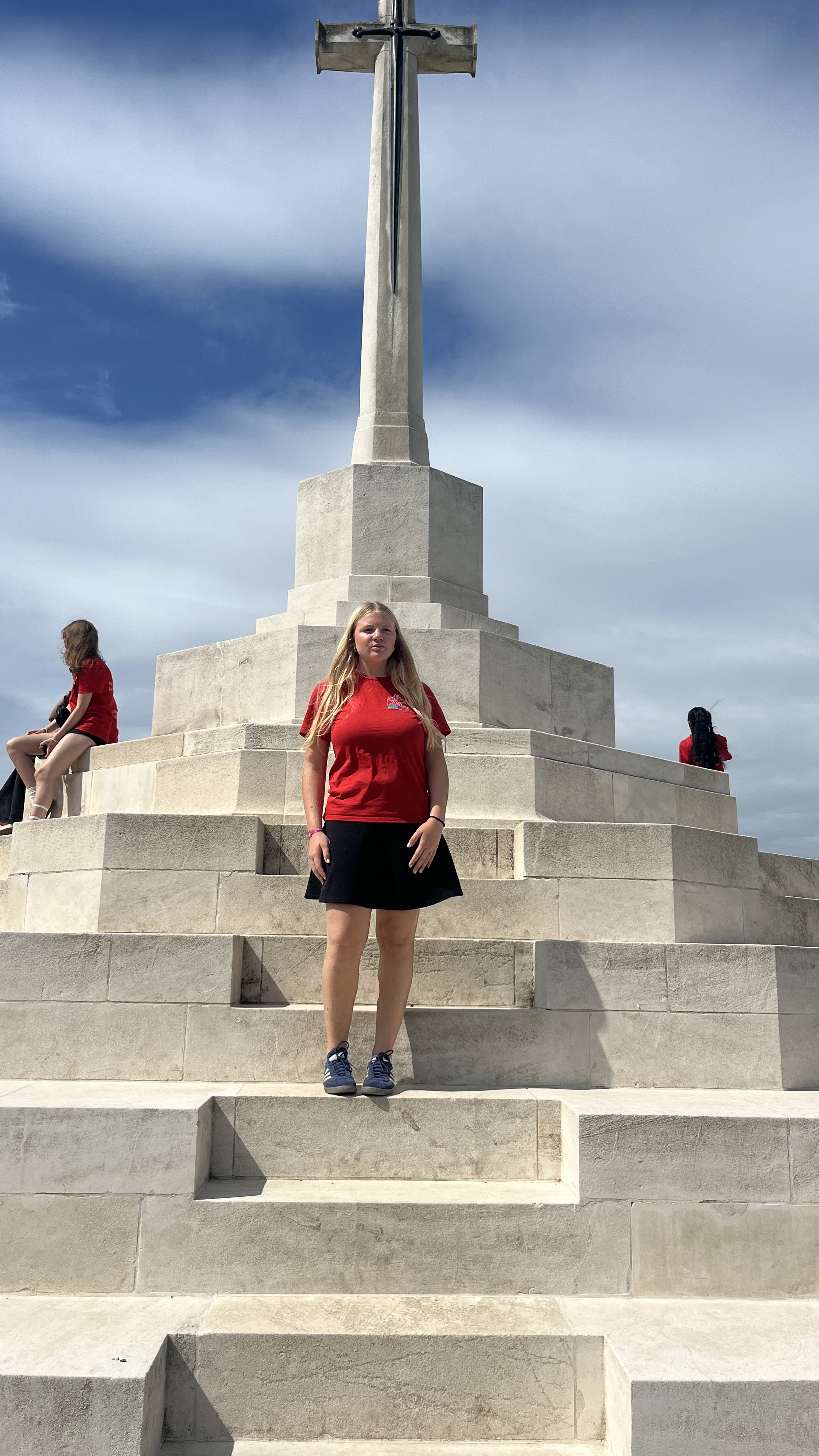
Today, we had the honor of listening to our guide Kim, who accompanied us to the battlefields in the Ypres region.
We discussed the First World War for the first time in the program. This is something I really appreciated, given that until then we had only talked about the Second World War. What surprised me was the fraternal relationships and strong bonds that united the soldiers during the First World War.
Kim enlightened us with anecdotes that most of us were already familiar with, such as the supposed football match between the German and British armies, which is actually just a myth.
There is no proof of its existence, and therefore it probably never took place! It's just a setup to make us believe it did, as it would have been such a beautiful and unique gesture. However, there was actually a Christmas truce where soldiers from both opposing sides met on no man's land for an evening for a semblance of conviviality and warmth.
I understand them and I think it's wonderful, because I couldn't imagine a Christmas without my family. I think that for the soldiers, meeting new people and being able to make peace for an evening must have been a truly suspended moment. I also learned that they sometimes exchanged their food rations between different armies. This shows that, despite the horror and the war, men can be humane in certain situations.
Another highlight of my day was the ceremony we attended in the evening. It was one of the things I found most moving about the trip: knowing that all our thoughts were connected at the same time for these soldiers who died for peace. I loved hearing the sound of the instruments echoing through the Menin Gate, then the silence of our thoughts.

.jpeg)
On the seventh day of the 2025 Beaverbrook Vimy Prize program, students continued their journey through the landscapes of the First World War.
The day began at Choques Military Cemetery, followed by a visit to the Citadelle de Doullens, where guides Gilles, Romain, and Laury welcomed the group. They offered a detailed presentation on the No. 3 Canadian Stationary Hospital, including a tour of the tunnels beneath the citadel where soldiers were accommodated and surgeries were performed during the war.
At Bagneux Military Cemetery, Louise shared a presentation on Nursing Sister Dorothy Baldwin, highlighting the role of women who served in the medical corps.
In the afternoon, the group visited the Beaumont-Hamel Newfoundland Memorial, where they were joined by the team from @memorialcameracanada, and ended the day at the imposing Thiepval Memorial, dedicated to the missing of the Somme.
Today’s reflections come from Charley and George.
Charley Colman

Today's itinerary began with a visit to Chocques Military Cemetery. It was at this cemetery that I was able to speak to the group about Lt. John Bower Lewis Heney. Heney was born and lived most of his life just a few blocks away from my home. During the First World War, Heney recieved the military medal for his actions at Vimy Ridge. Shortly afterwards he was transferred to the Royal Flying Corps as an observer. In February 1918, he was involved in a plane crash from which he was luckily able to walk away unscathed. This luck only lasted him another few weeks before tragedy struck. Soon after he had taken off on March 9, 1918, the plane's engine nearly stalled, prompting the pilot to turn the plane around. Unfortunately he lost control and the plane began to spin in the air, finally catching fire and exploding. Heney was only 23 years old.
The process of researching this soldier was in many ways like being able to get to know him. I tried my best to bring colour back into his story both metaphorically and literally. The main part of my reflection about Heney was a watercolour portait of him. This piece focuses primarily on this idea of bringing colour to his story but also the importance of community to connect us to the history of the World Wars.
While it was extremely impactful to be able to be at his gravesite, for me the most powerful moment was driving away. Up to that point in the program I was symbolically following in his steps. I was able to leave that cemetery but he never did.
George Crowther
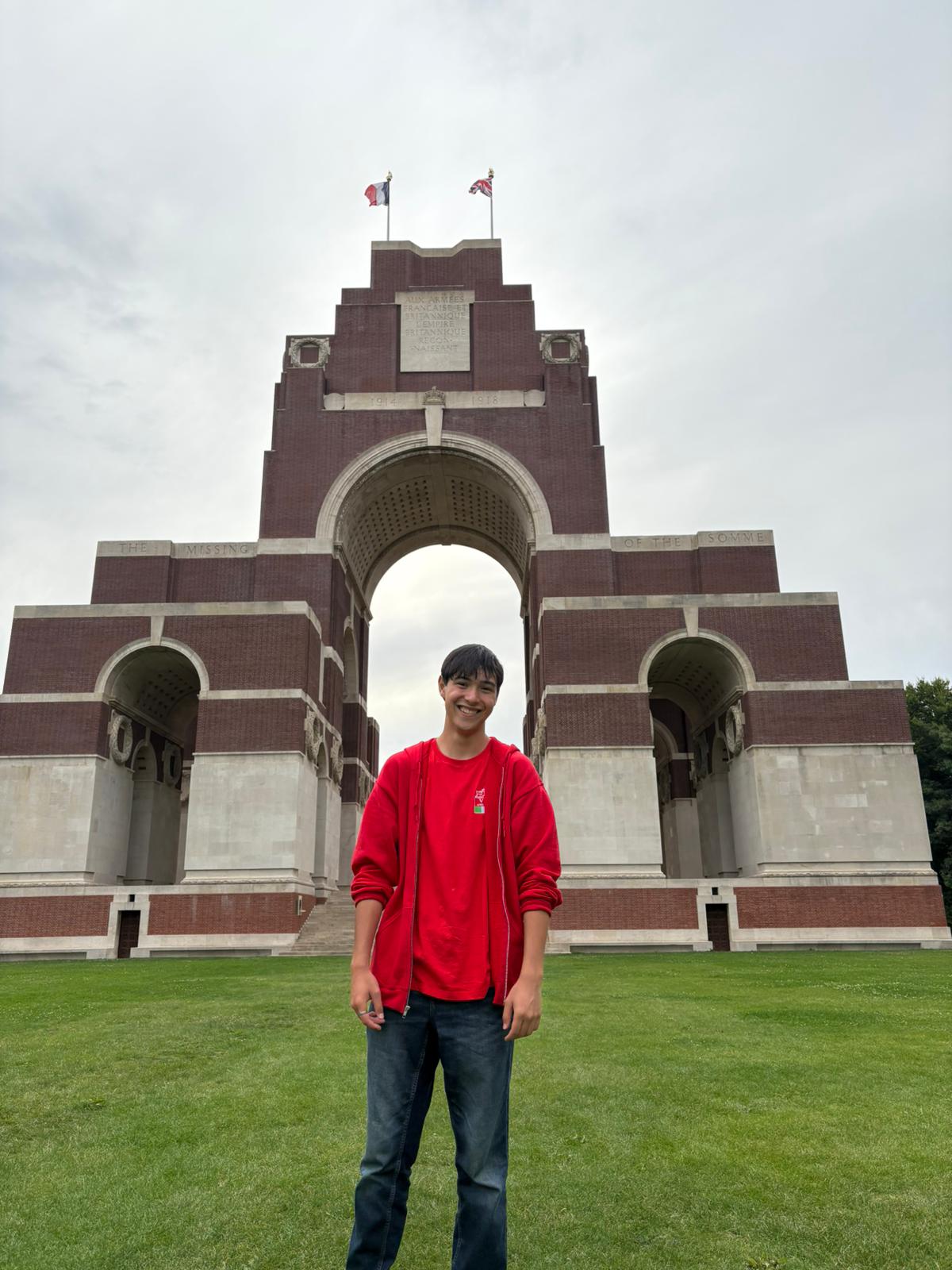
Personally, the most impactful site we visited today was the Doullens Citadel. The fortress was originally built in the year 1530 by King François 1er I to defend against the Spanish.
Upon the beginning of the First World War, and as the war evolved into the trench warfare we know today casualties quickly started sky rocketing. It became clear that there were not enough areas to treat them and so many medical facilities began to be constructed on quite a large scale. However this citadel was close enough to the front that it could simply be converted into a hospital. The station was given to the Canadians and was chosen due to the already existing military installation as well as its position near a supply hub making it an ideal place. Later in 1918 the German Empire bombed the Citadel from the air in a very unique instance. Our guides Romain, Gilles and Laury went over all this information and more while touring us through the area. We went into deep tunnels that aren't available to the public. It had been used to store patients and for surgery during the war, we also got to see many of the artifacts found during research digging onsite including some Canadian surgery tools and other specific items which were very interesting to see so far from home.
We were told that upon the fall of France in 1940 during the Second World War, Germany quite quickly occupied the fort, and before long it became a local military command center. A weather station was soon built in the fort. In 1943, the commander of the citadel required 25000 inmates to the commandant of Buchenwald concentration camp to construct additions to the base. We ourselves were able to tour several bunkers and areas built 80 years ago.
The experience itself was very powerful, walking through the cold dark halls it felt like I could almost feel the pain and suffering that went into their construction.The last stop in the citadel was a generator room near the front gate of the fort. As we walked inside to the larger room it became very clear why we were led there. On the wall inside lay the inscription 45502 1944. It can be assumed that 45502 was the number tattooed on the inmates arm, and 1944 was of course the year it was written. The concentration camp inmate likely did not have any more specific information on the date or their whereabouts and wrote all they knew. Walking in and seeing this was a very surreal experience for me. It didn't at all feel real and the moment took a second to sink in. Knowing what that person went through and realizing all the hell that happened right there. Not only that but the courage it must have taken to write that on the wall, if someone had seen it would have meant certain death but despite that this person who had gone through such unspeakable things was still willing to stand up in one last act of defiance before their murder. Defiance against the supposed crime they committed by existing. Defiance against the horrors of Nazism. And defiance in the spirit of hope. A truly powerful act and message, one that I know I will take with me for many many years to come.
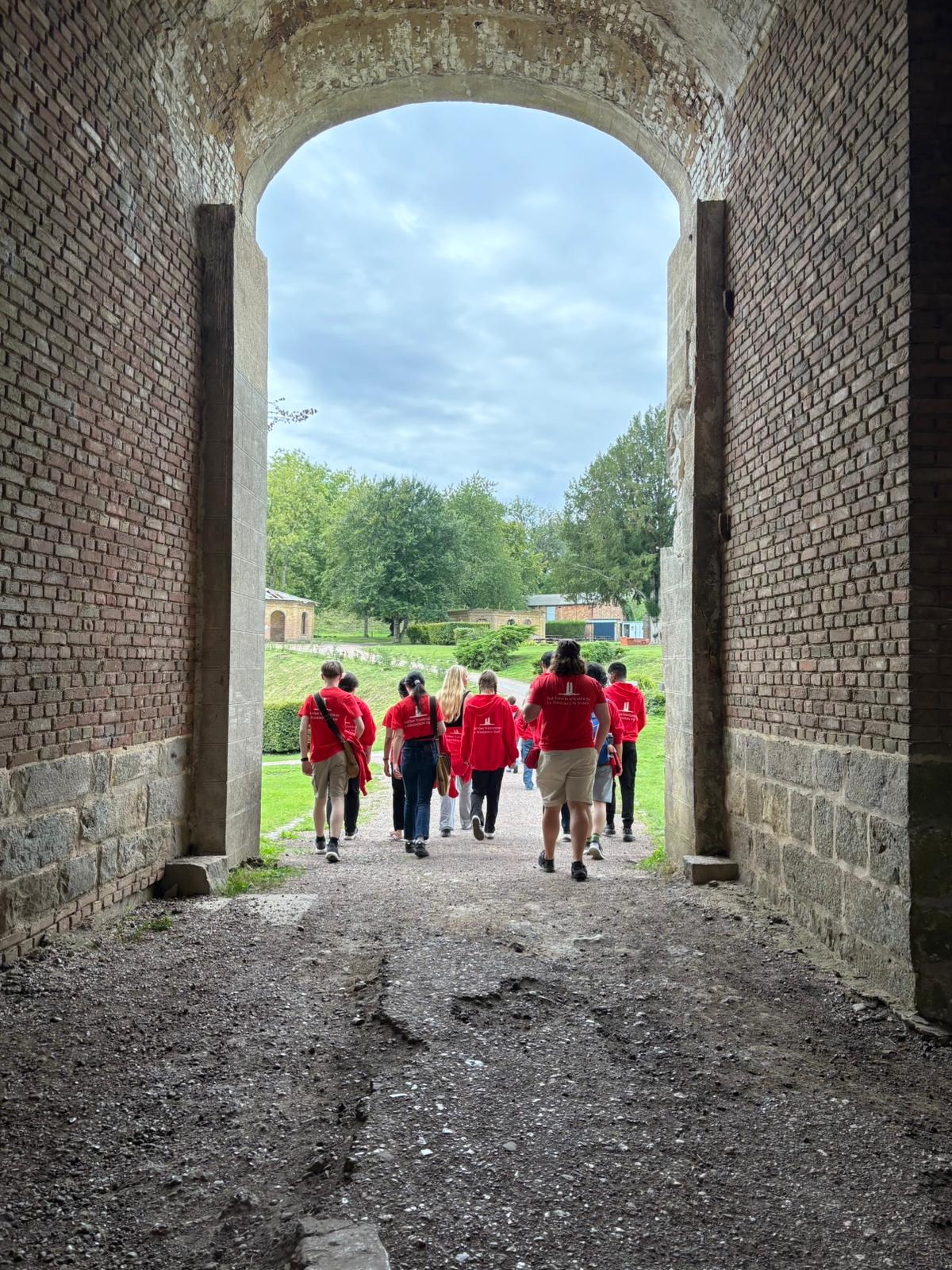
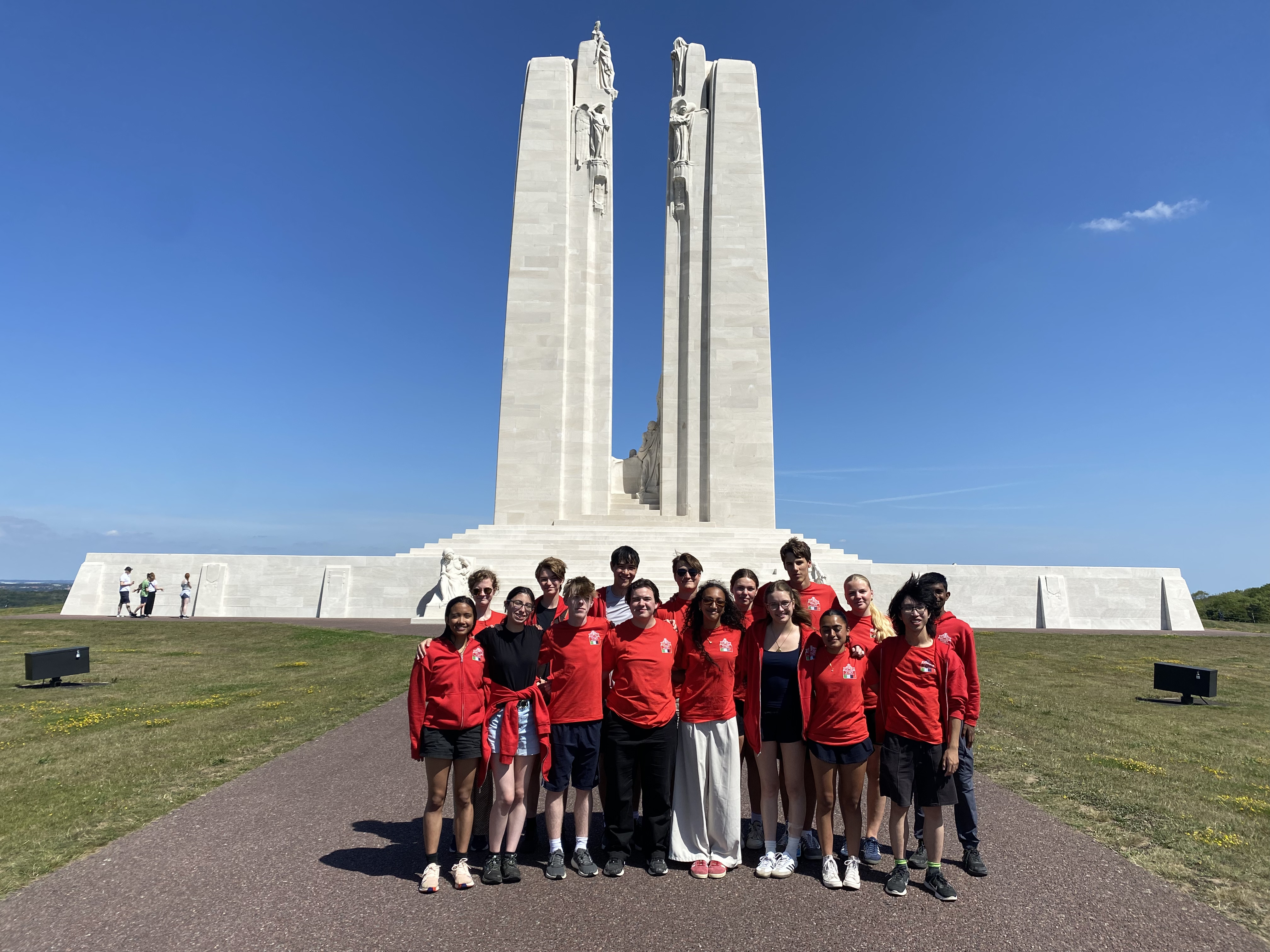
Today, students visited the Canadian National Vimy Memorial, the iconic site honouring Canadians who fought and died in the Battle of Vimy Ridge in April 1917. They toured the preserved trenches and entered the underground tunnels used to prepare for the assault, gaining insight into the scale and complexity of the battle.
In Arras, the group explored the Citadelle d’Arras, a 17th-century fortress later used by Allied forces during the First World War. At Hill 70, they learned about the August 1917 battle in which Canadian forces secured a key position overlooking the city of Lens.
The visit to Loos British Cemetery included a presentation from Renee Davis and Alex MacKinnon of the Casualty Identification Program, who explained the process used to identify unknown soldiers and honour their memory through proper commemoration.
The day concluded with a stop at Le Relais Thélusien, where the group enjoyed poutine — a taste of home in the heart of northern France.
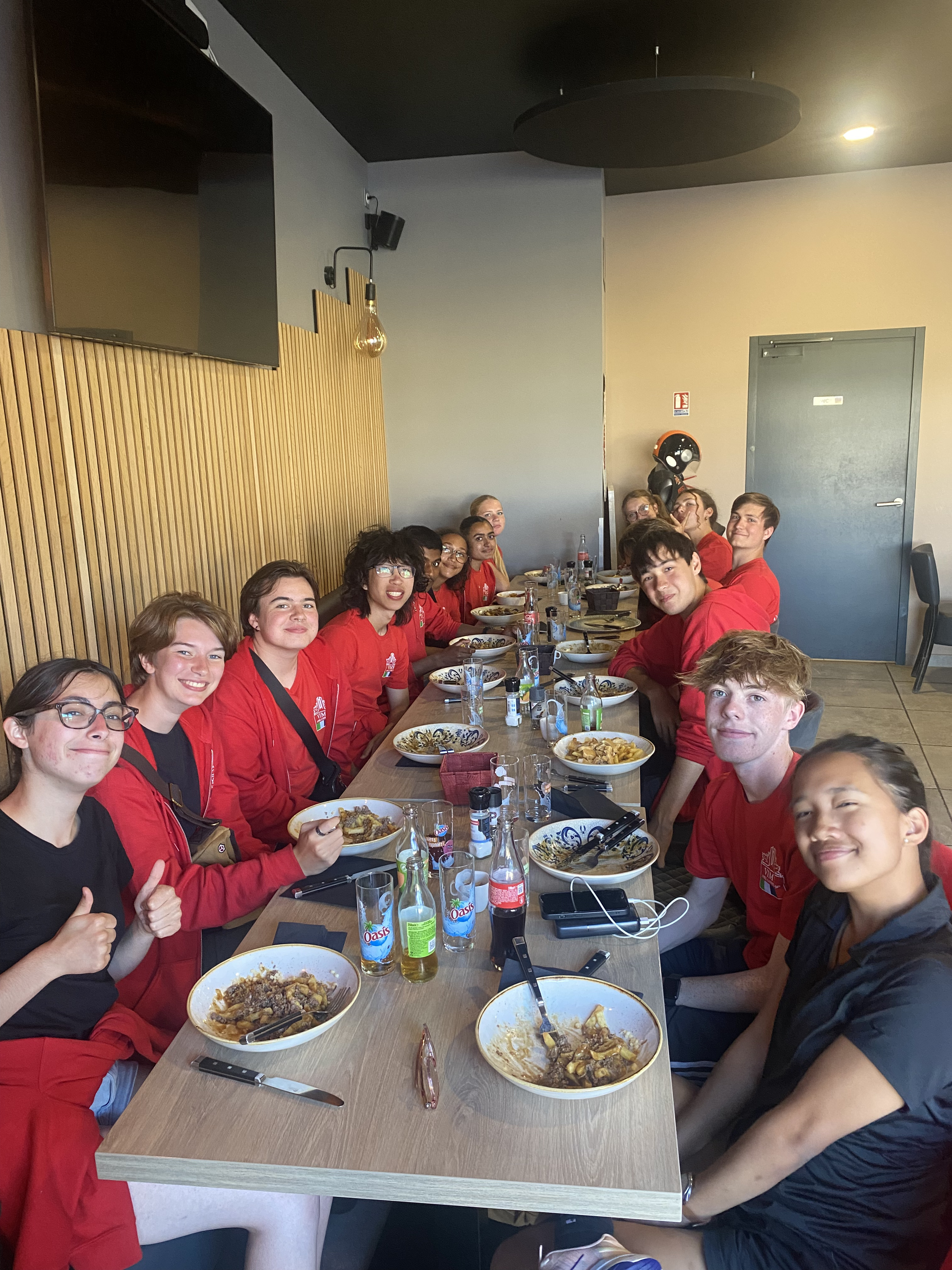

Today's reflection for Day 8 comes from Amelio.
Amelio Skinner
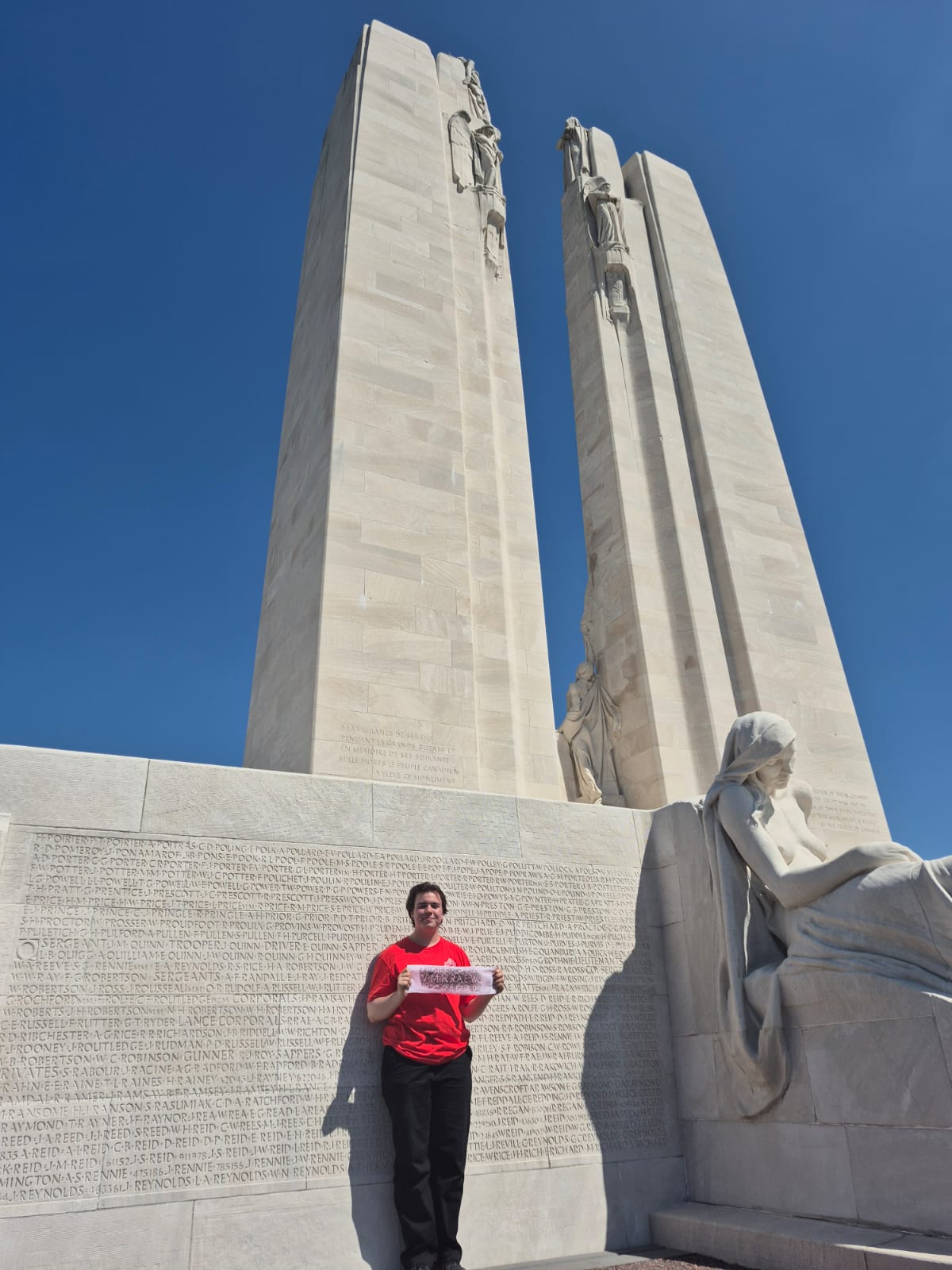
Today was a very meaningful day for me because of our visit to Vimy Ridge. After we visited the Citadel of Arras, we drove to Vimy where we got a tour in the underground tunnels dug during the First World War. There was originally 10 km of tunnelling under the ridge; more than a third of it is collapsed today. Our guide brought us through the non-collapsed parts as she told us about what it would have been like for the soldiers in 1917. We saw the rooms where people would have slept, planned, eaten, and sent messages to others via phone. For me, I was the most impacted by the graffiti and engravings left on the walls. It reminded me that our humanity as people, no matter the circumstance, will never change. It gives me hope for humanity, which is a feeling that has been common for me during my time with my fellow participants. After we finished the tour, we went to see the Vimy Memorial: this is where I did my soldier presentation. His name was Merlin Hamilton Rae, a young Albertan who fought in the battle of Thiepval Ridge. He was only 15 when he died in 1916. I was really afraid to do this presentation because it was very important to me that I honour Merlin Rae and tell his story properly. After my presentation and after I did a rubbing of his name on the monument, I noticed a strange grasshopper-like bug sitting on my right shoulder. Although I am not religious, I believe that those who have passed send messages to us. I saw this bug as Merlin visiting me to say that I represented him well. This got me thinking about how we mourn, a question that I continued to think about for the rest of the day. Why, over 100 years after the First World War and in a world that would be unrecognizable to Merlin Rae, are these memorials and cemeteries so important to us? Why do we continue to honour the people who have passed when our daily life is so disconnected from what it was like during the war and after all the survivors have passed? Why do I still care? I decided that the answer is the same as why I felt so impacted seeing the graffiti in the Vimy tunnels: we can’t help but be human. The millions who died during the Great War, although they lived vastly different lives from us, were still people. It’s easy to see the large numbers of deaths and casualties from the war and become desensitized. When we see evidence of individuality and hear or see the stories of real people though, we are reminded that they are just like us: then, we stay connected.
I think this summarizes the most impactful thing I learned during this program: the importance of telling stories. I look forward to bringing this lesson home with me on Monday, and I have plans to continue to tell the stories of those who died during the World Wars when I arrive back in Canada.
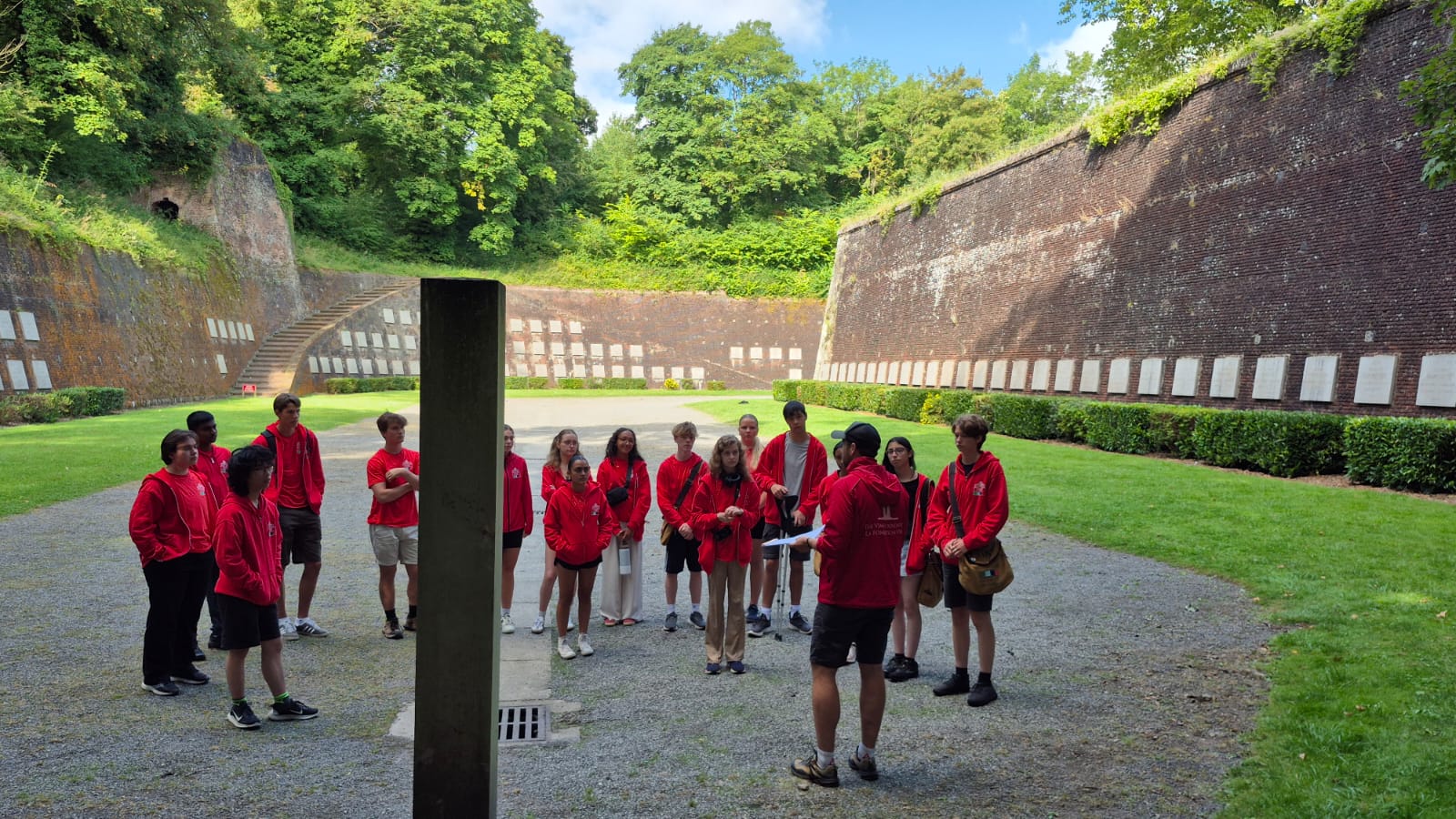
Day 9 – The Final Day of This Year’s Journey

The final day of the 2025 Beaverbrook Vimy Prize program began at Demuin British Cemetery, where students reflected on the lives commemorated in this quiet resting place. From there, they travelled to the Villers-Bretonneux Australian National Memorial, an impressive site honouring Australian soldiers who fought in France during the First World War.
The afternoon brought visits to Bourlon Wood, a key battlefield of the Hundred Days Offensive, and the Mons Memorial Museum, where students explored exhibits highlighting the local experience of both world wars. The day concluded at Saint-Symphorien Military Cemetery, a beautifully landscaped site notable for containing the graves of both Commonwealth and German soldiers — including some of the first and last casualties of the war.
And now, tomorrow, the students will make their way back home, marking the end of another successful Beaverbrook Vimy Prize program. The final reflections for this year come from Jeeya, Uzziel, and Milène.
Jeeya Patel
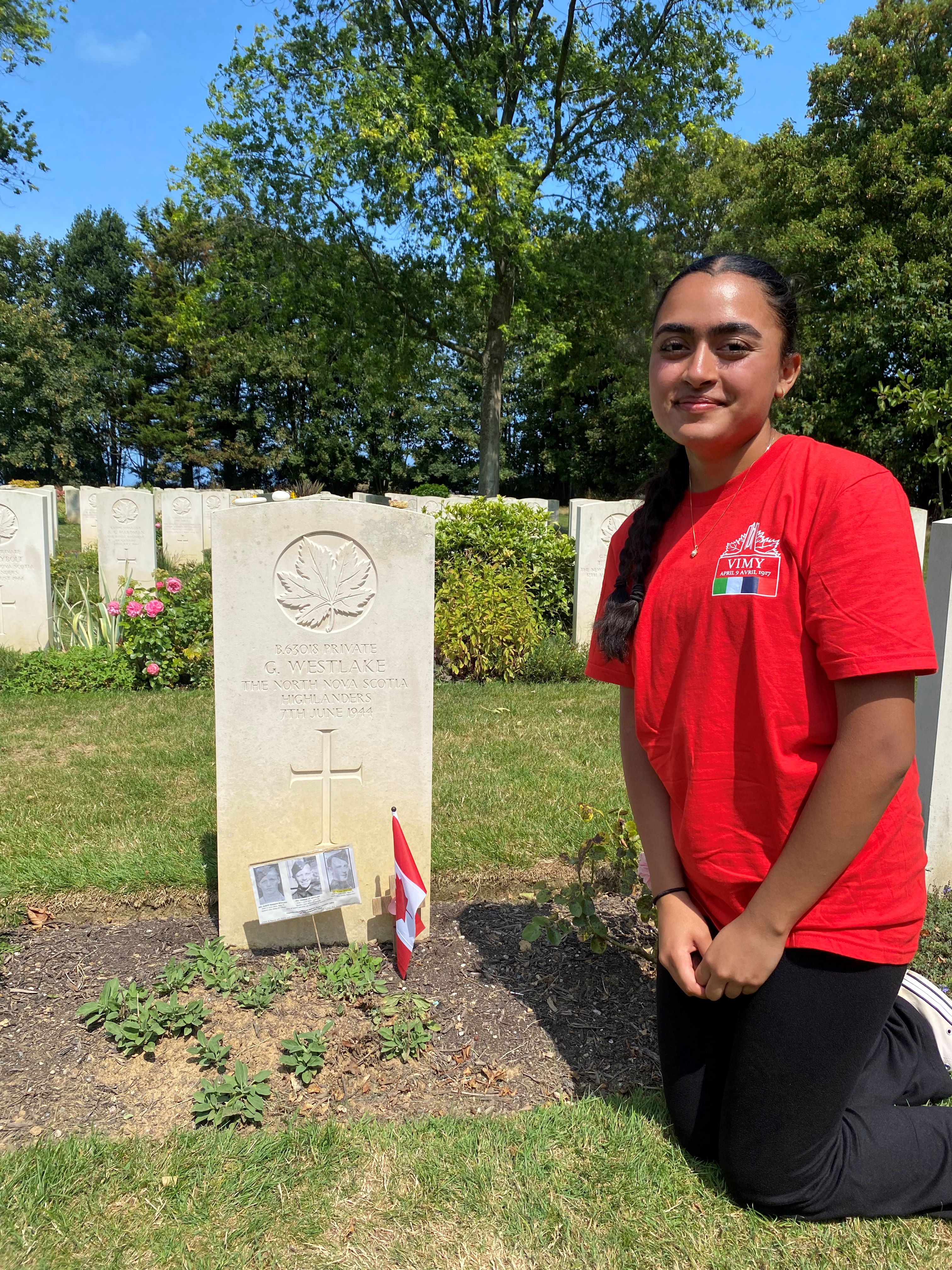
Throughout the past 9 days, we had the opportunity to visit many historical sites and museums and were able to expand our knowledge and understanding about the World Wars. Today, Olivia spoke about a civilian, who had resisted against the German nazi regime. He was a minor, who was about 16 years old. She spoke about his courageous efforts, and how he did not back down and stood up for what was right. It was very interesting to see the place where 218 French people were executed. Mur des Fusillés is a memorial that many people do not visit, so it was very interesting to see the exact spot where so many people had lost their lives. We also had a discussion about why all of these French civilians chose to resist the Nazi regime. Many of the 218 civilians that were executed did not have a family that they needed to worry about so they decided to resist against the Regime. We discussed about how during that time, if you were to resist, there was the risk that your family would face great consequences that might result in death, torture, or jail.
We also went to the Faubourg d’Amiens Cemetery and Arras Memorial where 35942 officers of the forces of the British empire died with no known grave. The Arras Memorial is also near a hospital (called St. John’s Hospital or Hôpital Saint-Jean) where many soldiers were treated to their many wounds that they suffered from.
We then went to the Loos Military Cemetery beside Hill 70. Many of the soldiers at this cemetery were unidentified and we learned about the process it takes to identify them. Alex and Renée people from the Canadian Casualty Identification Program spoke to us about the process. They spoke about one specific case where there was one unidentified soldier with many artifacts still with him. He wore his uniform, had his ribbons and badges, buttons, and a compass that still pointed North. In the soldier's pocket, there was a snuff box, filled with tobacco. In the box there was also a bracelet that had the soldier's name and his service number. Because of the way he was buried, the bracelet had ended up being in pristine condition. It was soon found out that the soldier's name was Kenneth Donald Duncanson, and that the bracelet was gifted to him by his wife. Duncanson’s family also gave photos of him where he was wearing the same bracelet on his wrist.
Uzziel Aruldoss
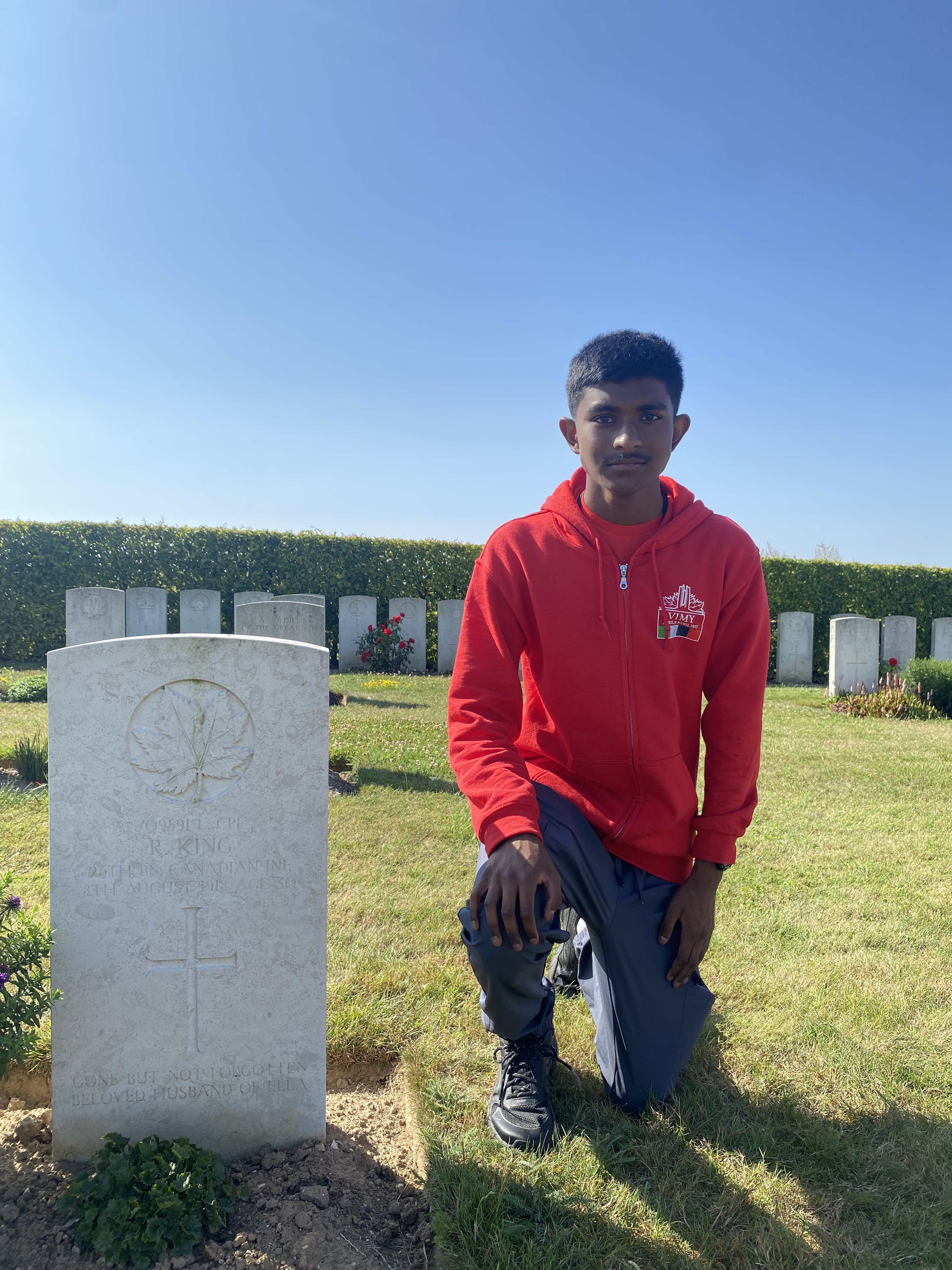
This last day of the program has been impactful, to say the least. We start off with Alaynna’s and my own soldier presentation in the morning. Our two presentations relate the major lessons learned from the past several programs through the battles, conditions of the soldiers, and Canada’s war effort that entail the journeys and stories of our soldiers. From understanding the battles and significance of Ypres to Vimy Ridge and finally the battle of Amiens, where it seems that both our soldiers met their demise. This felt like a fitting and comprehensive closure to our learning experience of the First World War, which I grew very interested in during my research.
Additionally, we had two group presentations today, one about the environmental impact of the World Wars and the other about the commemoration of soldiers. These presentations really made me reflect about the unintended and overlooked consequences of the World Wars. Such as the remaining live explosions and ammunition that still litter the old battlefields and even some cities and towns. We don’t want them there but also can’t do much about it either.
Furthermore, commemoration of fallen soldiers hasn’t been perfect or prioritized. This is due to a number of reasons, such as discrimination of minorities who participated in the war efforts and also because of some glorifying the wars over the humanity aspect of them. This shows that we still have a lot to learn regarding environmental issues and proper commemoration for all involved in the World Wars.
Additionally, we visited the museum of the history of Mons, Belgium. I found all the World War artifacts so interesting to view, as I try to imagine the soldiers, nurses, and civilians having to live in this unforgiving reality as part of their daily lives.
From the buried German bunkers of Normandy to the impactful visits to the old battlefields of Ypres, Vimy Ridge, and Passchendaele, this experience has opened my eyes to the reality of the World Wars. To end our learning journey, we partook in an immensely emotional and inspiring group discussion to sum up our journey together, as well as the biggest takeaways from learning about the World Wars. I love spending time with everyone and enjoying late nights together.
I’ll remember how I felt entering all these cemeteries, museums, and memorials together where my peers were able to bring new and different perspectives. This experience has changed my perspective on life and war. I’ve come to realize that this life should be spent being united with each other, rather than against.
Milène Card
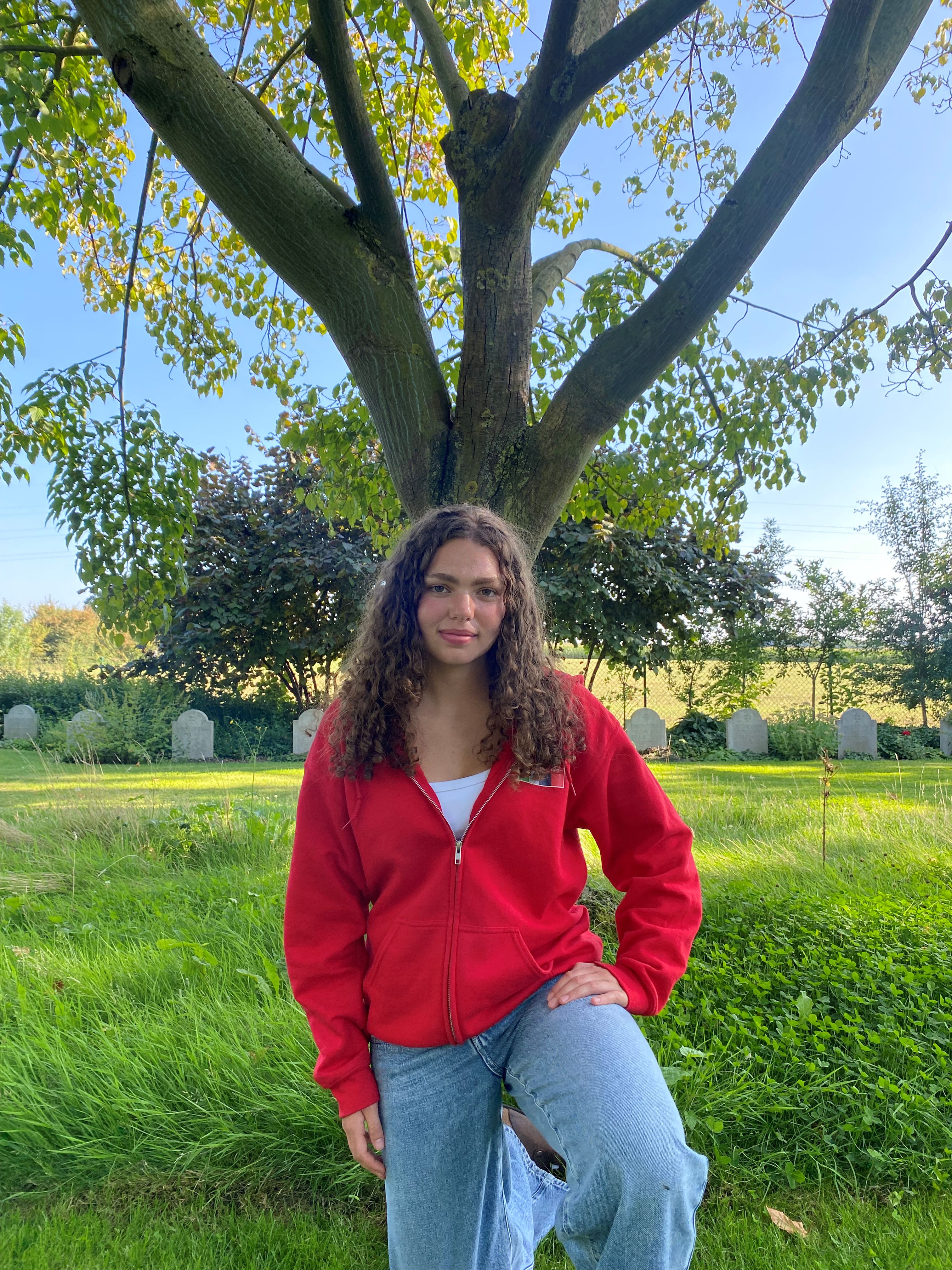
I think we all woke up today with a sense of dread, knowing it was the last day we’d spend together. Although I knew the end was approaching at frightening speeds, and it was hard to think about anything else, we had two wonderful presentations from Alayna and Uzziel that reminded me why we are all part of this program.
Alaynna presented at the Demuin Cemetery and read a heartfelt letter to her soldier, who had lived in the same town as she does. Her letter ended with a quote that struck me deeply: “If I am killed for simply living, let death be kinder than man.”
For Uzziel’s presentation, we went to the Villers-Bretonneux Cemetery, where he read a powerful monologue from the perspective of his soldier in his final moments. The imagery he used stayed with me, leaving me to wonder the same question I asked myself when I first entered this program: Why did they all have to die? Although I have learned a great deal throughout this program, I still haven’t found a satisfying answer. I will keep searching for one, but I simply do not think anyone can truly tell me why such atrocities had to happen.
After Uzziel’s presentation, we explored the Villers-Bretonneux Cemetery, marked by a striking tower that, when climbed, gave us a clear view of the battlefield of the Hundred Days Offensive. From the top, we saw a simple yet beautiful landscape, reminiscent of the Canadian prairies. It showed almost no trace of the battle that had taken place over a century ago, yet it is the final resting place of hundreds of thousands of soldiers of the Great War. While the physical signs of battle have long been erased, we cannot let the memory vanish with them. This is why commemoration is so important.
The last site we visited today, and the last we will ever visit as a group, was the St. Symphorien Military Cemetery in Mons, Belgium. I found it a fitting place to, in a way, end the program. Through Charley, Mars, and Jayden’s presentation, we learned about how the British, French, and Canadians commemorate the World Wars, and we discussed how we can do our part in contributing to this memory and commemoration.
I have spent the past ten days learning an immense amount about the World Wars, but I have also met a group of people I am not ready to part with. In less than twenty-four hours, we will be scattered to what feels like opposite ends of the world, and this program will truly be over. I wish I could have just a few more moments with everyone, but that is impossible. The fleeting nature of this experience has made me appreciate it all the more. Even if, one day, I forget everyone’s names and faces, I will never forget the way I felt surrounded by them during this unforgettable journey, and words cannot express how thankful I am to have had the opportunity to experience this program.
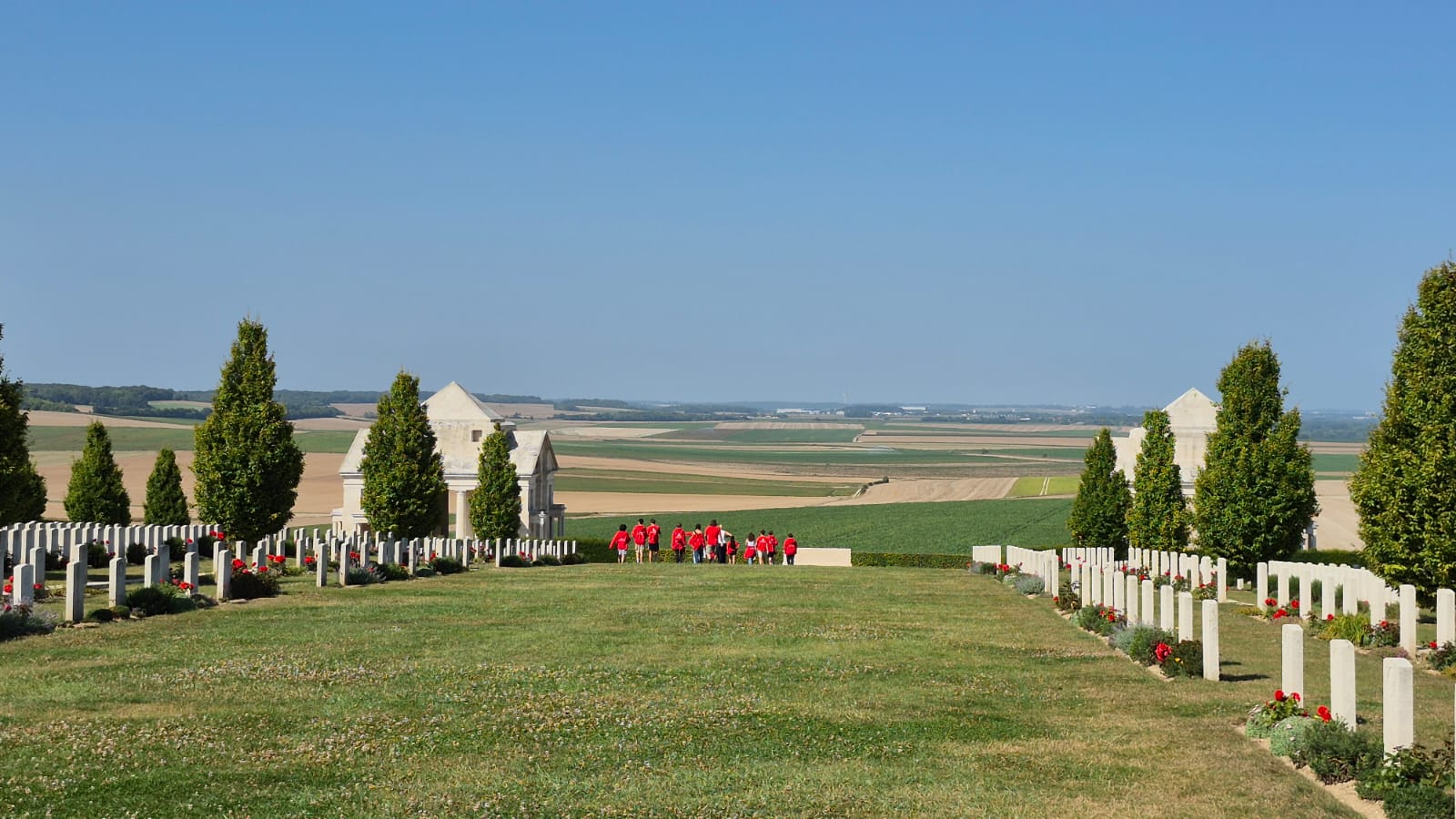
Check out our products in our boutique
View All Products


$ 39.99
$ 39.99
.png)
$ 60.00
$ 60.00